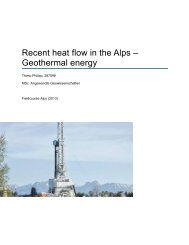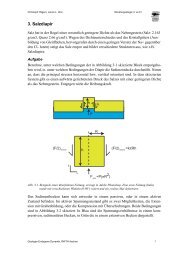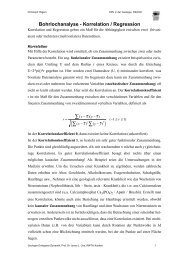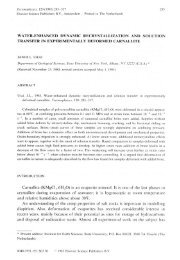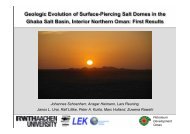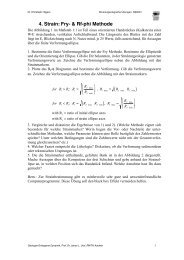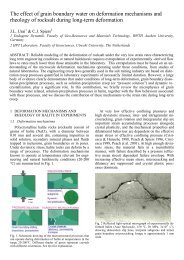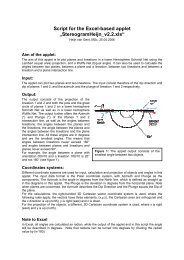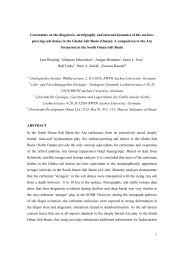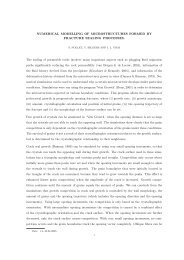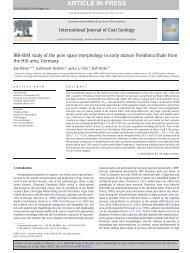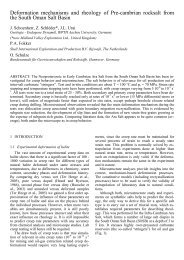Sealing of fluid pathways in overpressure cells - Ged.rwth-aachen.de
Sealing of fluid pathways in overpressure cells - Ged.rwth-aachen.de
Sealing of fluid pathways in overpressure cells - Ged.rwth-aachen.de
You also want an ePaper? Increase the reach of your titles
YUMPU automatically turns print PDFs into web optimized ePapers that Google loves.
Int J Earth Sci (Geol Rundsch) (2005) 94: 1039–1055<br />
DOI 10.1007/s00531-005-0492-1<br />
ORIGINAL PAPER<br />
S<strong>of</strong>ie Nollet Æ Christoph Hilgers Æ Janos Urai<br />
<strong>Seal<strong>in</strong>g</strong> <strong>of</strong> <strong>fluid</strong> <strong>pathways</strong> <strong>in</strong> <strong>overpressure</strong> <strong>cells</strong>: a case study<br />
from the Buntsandste<strong>in</strong> <strong>in</strong> the Lower Saxony Bas<strong>in</strong> (NW Germany)<br />
Received: 20 October 2004 / Accepted: 18 March 2005 / Published onl<strong>in</strong>e: 30 June 2005<br />
Ó Spr<strong>in</strong>ger-Verlag 2005<br />
Abstract We studied ve<strong>in</strong>s <strong>in</strong> the Triassic Buntsandste<strong>in</strong><br />
<strong>of</strong> the Lower Saxony Bas<strong>in</strong> (NW Germany) with the aim<br />
<strong>of</strong> quantify<strong>in</strong>g the evolution <strong>of</strong> <strong>in</strong>-situ stress, <strong>fluid</strong>s and<br />
material transport. Different generations <strong>of</strong> ve<strong>in</strong>s are<br />
observed. The first generation formed <strong>in</strong> weakly consolidated<br />
rocks without a significant <strong>in</strong>crease <strong>in</strong> fracture<br />
permeability and was filled syntectonically with fibrous<br />
calcite and blocky to elongate-blocky quartz. The stable<br />
isotopic signature (d 18 O and d 13 C) <strong>in</strong>dicates that the<br />
calcite ve<strong>in</strong>s precipitated from connate water at temperatures<br />
<strong>of</strong> 55–122°C. The second ve<strong>in</strong> generation was<br />
syntectonically filled with blocky anhydrite, which grew<br />
<strong>in</strong> open fractures. Fluid <strong>in</strong>clusions <strong>in</strong>dicate that the<br />
anhydrite ve<strong>in</strong>s precipitated at a m<strong>in</strong>imum temperature<br />
<strong>of</strong> 150°C from hypersal<strong>in</strong>e br<strong>in</strong>es. Based on d 34 S measurements,<br />
the source <strong>of</strong> the sulphate was found <strong>in</strong> the<br />
un<strong>de</strong>rly<strong>in</strong>g Zechste<strong>in</strong> evaporites. The macro- and microstructures<br />
<strong>in</strong>dicate that all ve<strong>in</strong>s were formed dur<strong>in</strong>g<br />
subsi<strong>de</strong>nce and that the anhydrite ve<strong>in</strong>s were formed<br />
un<strong>de</strong>r conditions <strong>of</strong> <strong>overpressure</strong>, generated by <strong>in</strong>flation<br />
rather than non-equilibrium compaction. The large<br />
amount <strong>of</strong> <strong>fluid</strong>s which are formed by the <strong>de</strong>hydrat<strong>in</strong>g<br />
gypsum <strong>in</strong> the un<strong>de</strong>rly<strong>in</strong>g Zechste<strong>in</strong> and are released <strong>in</strong>to<br />
the Buntsandste<strong>in</strong> dur<strong>in</strong>g progressive burial form a likely<br />
source <strong>of</strong> <strong>overpressure</strong>s and the anhydrite form<strong>in</strong>g <strong>fluid</strong>s.<br />
Keywords Ve<strong>in</strong>s Æ Lower Saxony Bas<strong>in</strong> Æ Overpressure<br />
Introduction<br />
The role <strong>of</strong> <strong>fluid</strong>s dur<strong>in</strong>g the evolution <strong>of</strong> sedimentary<br />
bas<strong>in</strong>s is partly recor<strong>de</strong>d by cements <strong>in</strong> the rock matrix<br />
and ve<strong>in</strong>s. Dur<strong>in</strong>g subsi<strong>de</strong>nce, porosity is reduced by<br />
S. Nollet (&) Æ C. Hilgers Æ J. Urai<br />
Geologie-Endogene Dynamik, RWTH Aachen,<br />
Lochnerstr. 4-20, 52056 Aachen, Germany<br />
E-mail: s.nollet@ged.<strong>rwth</strong>-<strong>aachen</strong>.<strong>de</strong><br />
Tel.: +49-241-8095416<br />
Fax: +49-241-8092358<br />
compaction. Connate and diagenetic/metamorphic <strong>fluid</strong>s<br />
are released by the <strong>de</strong>water<strong>in</strong>g <strong>of</strong> m<strong>in</strong>erals—for<br />
example the smectite–illite transition (Bruce 1984;<br />
Bjørlykke et al. 1989; Bek<strong>in</strong>s et al. 1994) or the <strong>de</strong>hydration<br />
<strong>of</strong> gypsum (Hardie 1967; Shearman et al. 1972).<br />
Additional <strong>fluid</strong>s can be released by the maturation <strong>of</strong><br />
organic components produc<strong>in</strong>g hydrocarbons (Bre<strong>de</strong>hoeft<br />
et al. 1994; Law and Spencer 1998). Besi<strong>de</strong>s these<br />
<strong>in</strong>tr<strong>in</strong>sic processes, bas<strong>in</strong> scale advective <strong>fluid</strong> flow <strong>of</strong><br />
meteoric waters is common, usually along fractures<br />
(Gross et al. 1992, Mo¨ ller et al. 1997). In a sedimentary<br />
bas<strong>in</strong>, a number <strong>of</strong> processes may produce <strong>de</strong>viations<br />
from hydrostatic pore pressure and thus drive <strong>fluid</strong> flow<br />
along a hydraulic gradient, for example topography<br />
(gravity-driven flow), compaction, thermal gradients<br />
(e.g. around salt domes due to the higher thermal conductivity<br />
<strong>of</strong> halite), or tectonic stresses (dilatancy and<br />
tectonic pump<strong>in</strong>g).<br />
Fluid <strong>overpressure</strong>s may be generated <strong>in</strong> the presence<br />
<strong>of</strong> a seal (such as clays and evaporites), the processes<br />
be<strong>in</strong>g either un<strong>de</strong>rcompaction (if the rock cannot dra<strong>in</strong><br />
fast enough dur<strong>in</strong>g subsi<strong>de</strong>nce), or <strong>in</strong>flation (if <strong>fluid</strong><br />
pressure rises after compaction by the <strong>in</strong>troduction <strong>of</strong><br />
additional pore <strong>fluid</strong>; Law and Spencer 1998; Townend<br />
and Zoback 2000). Extension fractures may form un<strong>de</strong>r<br />
many different conditions, <strong>de</strong>pend<strong>in</strong>g on the ratio <strong>of</strong> the<br />
rock’s compressive strength and the effective stress<br />
(Ingram and Urai 1999). Extension fractur<strong>in</strong>g may occur<br />
un<strong>de</strong>r conditions <strong>of</strong> overpressur<strong>in</strong>g when <strong>fluid</strong> pressures<br />
are as low as 0.6 times the total vertical stress (Ingebritsen<br />
and Sanford 1998, p 104).<br />
All <strong>of</strong> these processes could be relevant to the Triassic<br />
Ma<strong>in</strong> Buntsandste<strong>in</strong> <strong>in</strong> the Lower Saxony Bas<strong>in</strong>, which<br />
is characterized by Permian to Jurassic rift<strong>in</strong>g and<br />
Cretaceous <strong>in</strong>version, accompanied by salt tectonics<br />
(Ziegler 1990; Br<strong>in</strong>k et al. 1992; Scheck et al. 2003)<br />
(Fig. 1).<br />
Fluid activity may be recor<strong>de</strong>d <strong>in</strong> a rock when<br />
changes <strong>in</strong> parameters like temperature, pressure or <strong>fluid</strong><br />
chemistry cause supersaturation and the precipitation <strong>of</strong><br />
solute as cements or ve<strong>in</strong>s. Ve<strong>in</strong> microstructures may
1040<br />
Fig. 1 Overview map <strong>of</strong> the<br />
central and western part <strong>of</strong> the<br />
southern Permian Bas<strong>in</strong> with<br />
ma<strong>in</strong> structures (LBM London<br />
Brabant Massif, RM Rhenish<br />
Massif, LSB Lower Saxony<br />
Bas<strong>in</strong>, CG Central Graben, PB<br />
Pompeckj Block and RH<br />
R<strong>in</strong>gkøb<strong>in</strong>g-Fyn High). Inset<br />
shows an enlarged map <strong>of</strong> the<br />
LSB with the location <strong>of</strong> the<br />
four sampled boreholes and the<br />
ma<strong>in</strong> structural elements<br />
(normal faults, reverse faults<br />
and salt domes) (after Ziegler<br />
1990; Baldschuhn et al. 2001)<br />
UK<br />
NL<br />
London Amsterdam<br />
B<br />
CG RH<br />
LSB<br />
LBM RM<br />
D<br />
Borehole 1<br />
Ems<br />
Hamburg<br />
Hannover<br />
Borehole 3<br />
Osnabrück<br />
PB<br />
LSB<br />
Weser<br />
Weser<br />
Borehole 4<br />
Le<strong>in</strong>e<br />
Hannover<br />
Borehole 2<br />
N<br />
53°<br />
52°<br />
Legend:<br />
7° 8°<br />
9° 10°<br />
normal fault salt structure<br />
reverse fault<br />
25 km<br />
vary wi<strong>de</strong>ly with crystal habits rang<strong>in</strong>g from <strong>de</strong>ndritic,<br />
fibrous, elongate-blocky to blocky crystals, <strong>de</strong>pend<strong>in</strong>g<br />
on the boundary conditions <strong>of</strong> crystal growth (Ramsay<br />
and Huber 1983; Sunagawa 1984; Bons and Jessell 1997;<br />
Hilgers et al. 2001).<br />
Syntectonic ve<strong>in</strong> microstructures can be divi<strong>de</strong>d <strong>in</strong>to<br />
antitaxial, syntaxial, stretched (or ataxial crystals) and<br />
blocky ve<strong>in</strong>s. Antitaxial ve<strong>in</strong>s are <strong>of</strong>ten fibrous and grow<br />
from the ve<strong>in</strong> centre towards both si<strong>de</strong>s <strong>of</strong> the wall.<br />
Fibres are optically cont<strong>in</strong>uous even when they are<br />
curved and these fibres may sometimes be used to <strong>in</strong>fer<br />
the fracture’s open<strong>in</strong>g k<strong>in</strong>ematics (Ramsay and Huber<br />
1983; Uraietal.1991; Hilgers et al. 2001). Syntaxial<br />
ve<strong>in</strong>s are overgrowths <strong>of</strong> wall rock material, grow<strong>in</strong>g<br />
from the walls towards the centre <strong>of</strong> the ve<strong>in</strong> (Durney<br />
and Ramsay 1973). Their microstructure is usually<br />
elongate-blocky rather than truly fibrous (Bons 2000).<br />
Stretched ve<strong>in</strong>s may conta<strong>in</strong> fibrous crystals and connect<br />
fractured wall rock gra<strong>in</strong>s. Although they are assumed<br />
to have formed by <strong>de</strong>localized fractur<strong>in</strong>g (Passchier and<br />
Trouw 1996, p 135), at least some ve<strong>in</strong>s show clear evi<strong>de</strong>nce<br />
for accretion at the ve<strong>in</strong>-wall <strong>in</strong>terface (Hilgers<br />
and Urai 2002). From the ve<strong>in</strong> microstructure, the<br />
dimensions <strong>of</strong> the <strong>fluid</strong> <strong>pathways</strong> can be estimated. For<br />
example, euhedral crystals grew <strong>in</strong> open fractures or<br />
voids, while fibrous ve<strong>in</strong>s, even when they are centimetre-wi<strong>de</strong>,<br />
can only be formed when the <strong>in</strong>cremental crack<br />
open<strong>in</strong>gs are less than about 10 lm (Hilgers et al. 2001).<br />
Thus, microstructures conta<strong>in</strong> significant <strong>in</strong>formation<br />
on the boundary conditions dur<strong>in</strong>g ve<strong>in</strong> emplacement.<br />
Precipitation from <strong>fluid</strong>s as <strong>in</strong>tergranular cements <strong>in</strong><br />
the Triassic sandstones <strong>in</strong> the Central European Bas<strong>in</strong><br />
was studied by a number <strong>of</strong> researchers (Laier and<br />
Nielsen 1989; Rieken and Gaupp 1991; Purvis and<br />
Okkerman 1996; Weibel 1998, Putnis and Mauthe 2001;<br />
Weibel and Friis 2004). Laier and Nielsen (1989) showed<br />
that the Bunter Sandstone formation <strong>in</strong> Denmark,<br />
correspond<strong>in</strong>g to the Buntsandste<strong>in</strong> <strong>in</strong> Germany, is<br />
cemented with halite, which is ma<strong>in</strong>ly present <strong>in</strong> the<br />
sandstone layers. They suggested that the cement was<br />
formed very late <strong>in</strong> the diagenetic history and expla<strong>in</strong> the<br />
halite cementation by downward micro-filtration <strong>of</strong><br />
connate <strong>fluid</strong>s. Halite cementation is located above lowpermeable<br />
layers <strong>of</strong> shale, which these authors <strong>in</strong>terpreted<br />
as semi-permeable membranes.<br />
Purvis and Okkerman (1996) observed that the reservoir<br />
properties <strong>in</strong> the Ma<strong>in</strong> Buntsandste<strong>in</strong> (<strong>of</strong>fshore<br />
the Netherlands) are reduced by cementation with<br />
dolomite, anhydrite and halite. Sulphur isotopes <strong>in</strong>dicate<br />
that the source for anhydrite and halite was the un<strong>de</strong>rly<strong>in</strong>g<br />
Zechste<strong>in</strong>. In North-West Germany, halite<br />
cementation is also observed <strong>in</strong> the Soll<strong>in</strong>g Formation<br />
with<strong>in</strong> the Buntsandste<strong>in</strong> (Putnis and Mauthe 2001).<br />
Rieken and Gaupp (1991) showed that <strong>in</strong> the Tho¨ nse<br />
gasfield area, dolomite, anhydrite and quartz precipitated<br />
<strong>in</strong> ve<strong>in</strong>s <strong>in</strong> the Buntsandste<strong>in</strong> at temperatures <strong>of</strong><br />
140–230°C. Based on vitr<strong>in</strong>ite reflectance data, they<br />
suggested that the ve<strong>in</strong>s were formed dur<strong>in</strong>g short episo<strong>de</strong>s<br />
<strong>of</strong> large-scale vertical <strong>fluid</strong> flow dur<strong>in</strong>g the Upper<br />
Cretaceous (Rieken and Gaupp 1991).<br />
In this study, we focus on sealed fractures <strong>in</strong> the Ma<strong>in</strong><br />
Buntsandste<strong>in</strong> <strong>in</strong> the Lower Saxony Bas<strong>in</strong> (LSB). The<br />
aim is to unravel the complex <strong>fluid</strong> history, <strong>in</strong> particular<br />
the <strong>fluid</strong> source, transport mechanisms and the evolution<br />
<strong>of</strong> <strong>in</strong>-situ stress. This has important consequences for the<br />
total flow rate and the bulk volume <strong>of</strong> <strong>fluid</strong> flow<strong>in</strong>g <strong>in</strong> a<br />
sedimentary bas<strong>in</strong>. We use stable isotopes and microthermometry<br />
to constra<strong>in</strong> p–T conditions and tim<strong>in</strong>g<br />
<strong>of</strong> ve<strong>in</strong> formation, and we will <strong>de</strong>duce the transport<br />
mechanism <strong>of</strong> anhydrite and the structural control<br />
dur<strong>in</strong>g ve<strong>in</strong> emplacement.<br />
Geological sett<strong>in</strong>g<br />
The LSB is part <strong>of</strong> the E–W trend<strong>in</strong>g southern Permian<br />
bas<strong>in</strong>, bor<strong>de</strong>red <strong>in</strong> the north by the R<strong>in</strong>gkøb<strong>in</strong>g–Fynn<br />
High (Scheck and Bayer 1999; Kossow and Krawczyk
1041<br />
2002) (Fig. 1). It was filled with Rotliegend clastic sediments<br />
and cyclic <strong>de</strong>posits <strong>of</strong> Zechste<strong>in</strong> evaporites (carbonates,<br />
sulphates and halite). Rotliegend sandstones<br />
and Zechste<strong>in</strong> carbonates are important reservoir rocks,<br />
with the Zechste<strong>in</strong> evaporites act<strong>in</strong>g as a regional seal<br />
(Ziegler 1990). Dur<strong>in</strong>g the Triassic, NNE–SSW oriented<br />
rift<strong>in</strong>g took place and cont<strong>in</strong>ental, brackish-mar<strong>in</strong>e red<br />
beds, shallow mar<strong>in</strong>e carbonates, sulphates and halite<br />
were <strong>de</strong>posited <strong>in</strong> an arid to semi-arid climate<br />
(Michelsen and Clausen 2002; Szurlies et al. 2003). The<br />
Lower Triassic Buntsandste<strong>in</strong> <strong>in</strong> northern Germany<br />
consists <strong>of</strong> three units (Fig. 2): (1) shaly sediments <strong>in</strong> the<br />
Lower Buntsandste<strong>in</strong>; (2) four <strong>de</strong>positional sub-cycles <strong>in</strong><br />
the Middle Buntsandste<strong>in</strong> that start with a regressive<br />
sand package formed by brai<strong>de</strong>d streams and sheet<br />
floods, and close with transgressive shales, <strong>de</strong>posited<br />
un<strong>de</strong>r ephemeral playa lake conditions and (3) mar<strong>in</strong>e<br />
shales, sulphate and halite series <strong>in</strong> the Upper Buntsandste<strong>in</strong><br />
(Ro¨ t) (Herrmann et al. 1968; Ziegler 1990;<br />
Kovalevych et al. 2002; Michelsen and Clausen 2002).<br />
Dur<strong>in</strong>g the time <strong>of</strong> rapid subsi<strong>de</strong>nce <strong>in</strong> the Late<br />
Jurassic, WNW–ESE oriented normal faults were<br />
formed, for example <strong>in</strong> the Glu¨ ckstadt Graben (Br<strong>in</strong>k<br />
et al. 1992; Scheck et al. 2003). In the LSB, <strong>in</strong>version<br />
started <strong>in</strong> the Turonian and peaked dur<strong>in</strong>g the Santonian<br />
and Campanian. Total maximum <strong>in</strong>version uplift is<br />
estimated at 2 km to locally even 8 km, caus<strong>in</strong>g significant<br />
erosion. The <strong>in</strong>version created thrusts along the<br />
bas<strong>in</strong> marg<strong>in</strong>s and flower structures (<strong>de</strong> Jager 2003;<br />
Kockel 2003). In the southern part <strong>of</strong> the LSB, rocks<br />
were subjected to higher burial and stronger <strong>in</strong>version,<br />
then <strong>in</strong> the northern part (Petmecky et al. 1999).<br />
Abnormally high maturities are observed at the time <strong>of</strong><br />
<strong>in</strong>version <strong>in</strong> the Bramsche area (western part <strong>of</strong> LSB),<br />
which are expla<strong>in</strong>ed by some authors by abnormally<br />
high heat flow due to magmatic <strong>in</strong>trusions, while others<br />
suggest that tectonic events caused <strong>de</strong>ep burial and the<br />
high temperatures (Br<strong>in</strong>k et al. 1992; Petmecky et al.<br />
1999).<br />
Initial (passive) diapirism <strong>of</strong> Zechste<strong>in</strong> salt was <strong>in</strong>itiated<br />
<strong>in</strong> the Late Triassic (Trusheim 1957; Br<strong>in</strong>k 1984;<br />
Br<strong>in</strong>k et al. 1992; Baldschuhn et al. 1998; Bayer et al.<br />
1999; Scheck et al. 2003). In the Upper Jurassic, salt<br />
mobilization cont<strong>in</strong>ued and broke through the weakest<br />
units <strong>of</strong> the Mesozoic cover (Jaritz 1980). From the<br />
Early Cretaceous until Early Cenozoic, salt diapirism<br />
persisted as <strong>in</strong>dicated by salt-rim syncl<strong>in</strong>es (Scheck et al.<br />
2003; Mohr et al. this volume).<br />
In this study, the Middle Buntsandste<strong>in</strong> was sampled<br />
<strong>in</strong> four boreholes <strong>in</strong> the LSB (Fig. 1), because this<br />
formation was affected by the structural and <strong>fluid</strong> history<br />
start<strong>in</strong>g from early salt movement to bas<strong>in</strong> <strong>in</strong>version.<br />
The four boreholes are located <strong>in</strong> different<br />
tectonic sett<strong>in</strong>gs (Fig. 3). Borehole 1 is located <strong>in</strong> an<br />
<strong>in</strong>version structure where faults have been reactivated<br />
dur<strong>in</strong>g the <strong>in</strong>version <strong>in</strong> the Late Cretaceous (Kockel<br />
2003). Borehole 2 is located <strong>in</strong> an anticl<strong>in</strong>al structure,<br />
related to salt dom<strong>in</strong>g (Rieken and Gaupp 1991). The<br />
structure <strong>of</strong> borehole 3 <strong>in</strong> the southern part <strong>of</strong> LSB is<br />
also located <strong>in</strong> an <strong>in</strong>version structure where Zechste<strong>in</strong><br />
salt <strong>in</strong>tru<strong>de</strong>d <strong>in</strong>to the overly<strong>in</strong>g Triassic sediments<br />
along faults (Baldschuhn et al. 2001). Borehole 4 is<br />
Fig. 2 Stratigraphic column <strong>of</strong><br />
the Middle Triassic (anh<br />
anhydrite, h halite) (after<br />
Borchert and Muir 1964;<br />
Baldschuhn et al. 2001) and<br />
table show<strong>in</strong>g the<br />
characteristics <strong>of</strong> the observed<br />
ve<strong>in</strong>s for each formation <strong>in</strong> the<br />
Middle Buntsandste<strong>in</strong> (cc<br />
calcite, anh anhydrite, h halite, d<br />
dolomite, qtz quartz)
1042<br />
Fig. 3 Simplified cross-sections<br />
<strong>of</strong> the sampled boreholes (after<br />
Baldschuhn et al. 2001).<br />
aBorehole 1, b Borehole 2,<br />
c Borehole 3 and d Borehole 4<br />
located above a salt pillow and at 4 km from a salt<br />
dome.<br />
Methods<br />
Standard th<strong>in</strong> sections (20–30 lm) were used for<br />
microstructural analyses and cathodolum<strong>in</strong>escence.<br />
Cathodolum<strong>in</strong>escence was carried out on a Technosyn<br />
Cold Cathodo Lum<strong>in</strong>escence Mo<strong>de</strong>l 8200 MkI un<strong>de</strong>r<br />
8.5–10.5 kV and 260–350 mA. Double polished, 150-<br />
lm-thick sections were prepared for <strong>fluid</strong> <strong>in</strong>clusion<br />
analyses <strong>in</strong> anhydrite, accord<strong>in</strong>g to the method <strong>de</strong>scribed<br />
<strong>in</strong> Muchez et al. (1994). Microthermometry was carried<br />
out on a L<strong>in</strong>kham stage (K.U.Leuven, Belgium), which<br />
was calibrated at 56.6, 21.2, 0.0 and 374.1°C with<br />
synthetic Syn Fl<strong>in</strong>c <strong>in</strong>clusions. Homogenization temperatures<br />
<strong>of</strong> <strong>in</strong>clusions were measured before freez<strong>in</strong>g.<br />
Freez<strong>in</strong>g may cause a volume <strong>in</strong>crease related to the<br />
liquid water–ice transition, which <strong>in</strong>duces <strong>de</strong>formation<br />
<strong>of</strong> the crystal and a volume change <strong>in</strong> the <strong>fluid</strong> <strong>in</strong>clusions.<br />
This volume change results <strong>in</strong> <strong>in</strong>correct homogenization<br />
temperatures (Reynolds and Goldste<strong>in</strong> 1990).<br />
For d 18 O V-PDB /d 13 C V-PDB measurements, carbonate<br />
pow<strong>de</strong>rs reacted with 100% phosphoric acid at 75°C<br />
us<strong>in</strong>g a Kiel III onl<strong>in</strong>e carbonate preparation l<strong>in</strong>e connected<br />
to a ThermoF<strong>in</strong>nigan 252 mass spectrometer<br />
(Institut fu¨ r Geologie und M<strong>in</strong>eralogie, Universität Erlangen-Nu¨<br />
rnberg, Germany). All values are reported <strong>in</strong><br />
per million relative to V-PDB by assign<strong>in</strong>g a d 18 O value<br />
<strong>of</strong> 2.20& and a d 13 C value <strong>of</strong> +1.95& to NBS19.<br />
Reproducibility was checked by replicate analysis <strong>of</strong><br />
laboratory standards and is better than ± 0.03 for d 13 C<br />
and ± 0.06 for d 18 O. Sulphur isotopes were measured <strong>in</strong><br />
an EA-ConfloII-F<strong>in</strong>nigan Delta+ mass spectrometer<br />
after mix<strong>in</strong>g <strong>of</strong> the SO 2 gas with V 2 O 5 at 1,050°C<br />
(Department <strong>of</strong> Geology-Westfa¨ lische Wilhelms-Universita¨<br />
tMu¨ nster, Germany). Results are reported <strong>in</strong> the<br />
standard <strong>de</strong>lta notation (d 34 S) as per mil difference relative<br />
to Canyon Diablo Troilite (CDT). Analytical<br />
reproducibility was generally better than ±0.4&.<br />
Macroscopic observations<br />
In boreholes 1, 3 and 4, the Middle Buntsandste<strong>in</strong> is<br />
located at <strong>de</strong>pths <strong>of</strong> around 2,500 m whereas <strong>in</strong> borehole<br />
2, the Middle Buntsandste<strong>in</strong> is at 3,400 m. All the<br />
boreholes are vertical and although they are located <strong>in</strong><br />
different tectonic sett<strong>in</strong>gs and up to 200 km apart, the<br />
ve<strong>in</strong> types and the ve<strong>in</strong>-fill<strong>in</strong>g m<strong>in</strong>erals are very similar <strong>in</strong><br />
the cores studied (Fig. 2).<br />
In all boreholes, the Soll<strong>in</strong>g Formation is composed<br />
<strong>of</strong> red–brown coloured, f<strong>in</strong>e-gra<strong>in</strong>ed silt- to claystone,<br />
cemented with calcite and dolomite. Green reduction<br />
spots with diameters <strong>of</strong> 1 cm are very <strong>of</strong>ten observed.<br />
Ve<strong>in</strong>s are frequent <strong>in</strong> the Soll<strong>in</strong>g Formation, with<br />
approximately one ve<strong>in</strong> <strong>in</strong> every 2 m core. They are filled<br />
ma<strong>in</strong>ly with anhydrite and calcite and rarely with only<br />
one <strong>of</strong> the two m<strong>in</strong>erals. Occasionally, ve<strong>in</strong>s with calcite<br />
and halite were found <strong>in</strong> borehole 2. Ve<strong>in</strong>s are oriented<br />
70° to 90° to bedd<strong>in</strong>g. The thickness <strong>of</strong> the ve<strong>in</strong>s ranges<br />
from 0.5 cm up to 3 cm. Ve<strong>in</strong>s are longer than the<br />
section exposed by the cores, and <strong>in</strong> one case where the<br />
ve<strong>in</strong> is parallel to the core axis, a ve<strong>in</strong> length <strong>of</strong> 3 m<br />
was observed. The fracture morphology <strong>of</strong> the calciteanhydrite<br />
and anhydrite ve<strong>in</strong>s is very regular (Fig. 4a).<br />
When the ve<strong>in</strong> consists <strong>of</strong> calcite and anhydrite, the<br />
calcite is located at the ve<strong>in</strong> walls whereas the anhydrite<br />
is located <strong>in</strong> the centre <strong>of</strong> the ve<strong>in</strong>. In the ve<strong>in</strong>s where<br />
halite and calcite are observed, the calcite is also located<br />
at the ve<strong>in</strong> wall and the halite <strong>in</strong> the centre. The ve<strong>in</strong>s<br />
with only calcite fill<strong>in</strong>g are th<strong>in</strong> (0.5 cm), have a smooth<br />
ve<strong>in</strong>-wall <strong>in</strong>terface <strong>in</strong> claystone and a more irregular<br />
morphology <strong>in</strong> coarser-gra<strong>in</strong>ed host rock. When cross<strong>in</strong>g<br />
a layer boundary <strong>in</strong>to coarser-gra<strong>in</strong>ed host rock,<br />
they split <strong>in</strong>to different mm-th<strong>in</strong> branches (Fig. 4b).<br />
The Har<strong>de</strong>gsen Formation is only present <strong>in</strong> borehole<br />
1 and consists <strong>of</strong> coarse-gra<strong>in</strong>ed, grey-green coloured<br />
sandstone with alternations <strong>of</strong> red–brown<br />
coloured clay-rich layers. It is <strong>of</strong>ten cemented with<br />
quartz and pyrite concretions are wi<strong>de</strong>ly present <strong>in</strong> this<br />
formation. Ve<strong>in</strong>s are only occasionally observed
1043<br />
Fig. 4 Rock samples show<strong>in</strong>g<br />
the different ve<strong>in</strong> generations.<br />
a Blocky calcite-anhydrite ve<strong>in</strong><br />
with very regular wall rock<br />
<strong>in</strong>terface. Calcite (cc) is located<br />
at the ve<strong>in</strong> wall and anhydrite<br />
(anh) <strong>in</strong> the ve<strong>in</strong> centre (sample<br />
B3-14). b Fibrous calcite ve<strong>in</strong><br />
with smooth wall-rock <strong>in</strong>terface<br />
<strong>in</strong> the claystone and irregular<br />
ve<strong>in</strong> branches <strong>in</strong> the coarsegra<strong>in</strong>ed<br />
sandstone (sample<br />
B2-08). S 0 =bedd<strong>in</strong>g plane<br />
(approximately 1 ve<strong>in</strong> <strong>in</strong> every 10 m core), have<br />
thicknesses smaller than 1 mm and are filled with<br />
anhydrite or very rarely halite. They are oriented 85° to<br />
90° to the bedd<strong>in</strong>g.<br />
The Detfurth Formation consists <strong>of</strong> red-brown,<br />
coarse-gra<strong>in</strong>ed sandstone with clay-rich <strong>in</strong>tercalations.<br />
Ve<strong>in</strong>s are rare, approximately one ve<strong>in</strong> <strong>in</strong> a 5 m core and<br />
are filled with anhydrite and calcite. Thicknesses vary<br />
between 0.5 cm and 1 cm and lengths are at least 30 cm<br />
(ve<strong>in</strong>s rarely term<strong>in</strong>ate <strong>in</strong> the core). The ve<strong>in</strong>s are oriented<br />
between 65° and 90° to the bedd<strong>in</strong>g. In borehole 4,<br />
very th<strong>in</strong> (1 mm or smaller) halite ve<strong>in</strong>s are occasionally<br />
observed <strong>in</strong> this formation.<br />
The Volpriehausen Formation is composed <strong>of</strong> red- to<br />
grey-coloured sandstone with clay-rich layers. Ve<strong>in</strong>s are<br />
rare (approximately 1 <strong>in</strong> every 30 m core) and are very<br />
th<strong>in</strong> (
1044<br />
Fig. 5 aMicrostructure show<strong>in</strong>g a calcite ve<strong>in</strong> <strong>in</strong> claystone. The<br />
ve<strong>in</strong> splits <strong>in</strong> different branches <strong>in</strong> the coarse-gra<strong>in</strong>ed siltstone (th<strong>in</strong><br />
section s78, normal to bedd<strong>in</strong>g, sample B2-08). b Calcite overgrowth<br />
<strong>in</strong> sandstone show<strong>in</strong>g that the ve<strong>in</strong> is <strong>de</strong>localized and does<br />
not cross the quartz gra<strong>in</strong>s <strong>of</strong> the host rock. Quartz gra<strong>in</strong>s are<br />
partly dissolved by pressure solution (th<strong>in</strong> section s81, normal to<br />
bedd<strong>in</strong>g, sample B3-19). c Antitaxial calcite ve<strong>in</strong> <strong>in</strong> claystone<br />
towards the ve<strong>in</strong> centre. Syntaxial growth resulted <strong>in</strong><br />
significant growth competition at the ve<strong>in</strong>–wall <strong>in</strong>terface,<br />
<strong>in</strong>dicat<strong>in</strong>g that the ve<strong>in</strong> grew syntectonically with a<br />
significant open<strong>in</strong>g (>10 lm) to the oppos<strong>in</strong>g wall.<br />
Microstructures suggest that some stretched calcite<br />
crystals grew contemporaneously with the quartz<br />
(Fig. 6b). Stretched crystals <strong>of</strong> quartz are clear evi<strong>de</strong>nce<br />
for syntectonic growth. The lateral variation from<br />
stretched crystals to elongate-blocky syntaxial growth<br />
suggests that the open cavity growth with euhedral<br />
crystal term<strong>in</strong>ations <strong>in</strong> the ve<strong>in</strong>s is also syntectonic.<br />
show<strong>in</strong>g small crystals <strong>in</strong> the centre, which grew towards both si<strong>de</strong>s<br />
<strong>of</strong> the wall. The ve<strong>in</strong> grew asymmetrically (th<strong>in</strong> section s78, normal<br />
to bedd<strong>in</strong>g, sample B2-08). d Cathodolum<strong>in</strong>escence image <strong>of</strong> a<br />
calcite ve<strong>in</strong> show<strong>in</strong>g that the cements <strong>in</strong> the host rock have the same<br />
lum<strong>in</strong>escence colour as the ve<strong>in</strong>. Note that fibres connect bedd<strong>in</strong>g<br />
on both si<strong>de</strong>s <strong>of</strong> the ve<strong>in</strong> <strong>in</strong> this example (th<strong>in</strong> section s78, normal<br />
to bedd<strong>in</strong>g, sample B2-08). cc calcite, qtz quartz<br />
Locally, anhydrite fills open vugs <strong>in</strong> the syntaxial ve<strong>in</strong>s,<br />
<strong>in</strong>dicat<strong>in</strong>g that quartz–calcite grew at an earlier phase.<br />
Anhydrite ve<strong>in</strong>s<br />
Anhydrite is found <strong>in</strong> extension ve<strong>in</strong>s oriented normal to<br />
bedd<strong>in</strong>g. Fracture surfaces are more regular, <strong>in</strong> contrast<br />
to the irregular morphology <strong>of</strong> the calcite ve<strong>in</strong>s,<br />
<strong>in</strong>dicat<strong>in</strong>g that the rocks were more consolidated dur<strong>in</strong>g<br />
this phase <strong>of</strong> ve<strong>in</strong> formation.<br />
Fig. 6 a Microstructures<br />
show<strong>in</strong>g a stretched quartz ve<strong>in</strong><br />
with few solid <strong>in</strong>clusions<br />
<strong>in</strong>corporated <strong>in</strong> the quartz<br />
crystals <strong>in</strong>dicat<strong>in</strong>g syntectonic<br />
growth (th<strong>in</strong> section s61_a,<br />
normal to bedd<strong>in</strong>g, sample<br />
B2-05). b Stretched quartz and<br />
calcite crystals suggest<strong>in</strong>g that<br />
both calcite and quartz<br />
precipitated<br />
contemporaneously. Faceted<br />
quartz with euhedral crystal<br />
term<strong>in</strong>ations are also observed<br />
<strong>in</strong> the same ve<strong>in</strong> (th<strong>in</strong> section<br />
s61_b, normal to bedd<strong>in</strong>g,<br />
sample B2-05). cc calcite, qtz<br />
quartz
1045<br />
Anhydrite ve<strong>in</strong>s conta<strong>in</strong> aggregates <strong>of</strong> clear needlelike<br />
radiat<strong>in</strong>g crystals (rosettes) or s<strong>in</strong>gle, th<strong>in</strong> needles,<br />
with well-<strong>de</strong>f<strong>in</strong>ed cleavage (Murray 1964; Holliday 1970)<br />
(Fig. 7a). The rosettes radiate from a s<strong>in</strong>gle blocky<br />
anhydrite crystal. Ve<strong>in</strong>s may have a blocky or elongateblocky<br />
microstructure, with growth competition at the<br />
ve<strong>in</strong>–wall <strong>in</strong>terface (Fig. 7b).<br />
Cross-cutt<strong>in</strong>g relationships <strong>of</strong> calcite ve<strong>in</strong>s or branches<br />
and anhydrite ve<strong>in</strong>s <strong>in</strong>dicate that calcite ve<strong>in</strong>s<br />
re-opened and were filled with anhydrite (Fig.7c). This<br />
<strong>in</strong>dicates that anhydrite ve<strong>in</strong><strong>in</strong>g postdates calcite<br />
ve<strong>in</strong><strong>in</strong>g.<br />
Halite ve<strong>in</strong>s<br />
In contrast to the other boreholes, borehole 2 conta<strong>in</strong>s<br />
centimetre thick halite ve<strong>in</strong>s <strong>in</strong> the Soll<strong>in</strong>g Formation.<br />
Halite is located <strong>in</strong> the centre <strong>of</strong> a calcite ve<strong>in</strong>, which is<br />
oriented normal to bedd<strong>in</strong>g (Fig. 8a). The ve<strong>in</strong> microstructure<br />
varies laterally from fibrous to blocky with<strong>in</strong> a<br />
s<strong>in</strong>gle ve<strong>in</strong>, <strong>in</strong>dicat<strong>in</strong>g syntectonic growth at different<br />
open<strong>in</strong>g or growth rates (Hilgers et al. 2001). Halite<br />
conta<strong>in</strong>s ma<strong>in</strong>ly primary subgra<strong>in</strong>s, recognized by their<br />
fibrous shape. Few gra<strong>in</strong>s show polygonal subgra<strong>in</strong>s,<br />
which are <strong>in</strong>dicative <strong>of</strong> <strong>de</strong>formation due to dislocation<br />
creep (Fig. 8b) (see also Schle<strong>de</strong>r and Urai this volume).<br />
The subgra<strong>in</strong> size is then <strong>in</strong>versely proportional to the<br />
differential stress (Carter et al. 1993). The subgra<strong>in</strong> size<br />
was measured and results suggest low differential stresses<br />
<strong>of</strong> around 1.4 MPa.<br />
Sulphate reduction<br />
Green reduction spots and pyrite concretions are frequently<br />
observed <strong>in</strong> the shaly host rock close to anhydrite<br />
ve<strong>in</strong>s. In these ve<strong>in</strong>s, calcite is locally present at the<br />
ve<strong>in</strong>–wall <strong>in</strong>terface and with<strong>in</strong> the ve<strong>in</strong>. The texture <strong>in</strong><br />
these ve<strong>in</strong>s po<strong>in</strong>ts to replacement <strong>of</strong> the anhydrite crystals<br />
by calcite at a later stage (Fig. 7d). This may <strong>in</strong>dicate<br />
that anhydrite was dissolved and thermochemical<br />
sulphate reduction took place with methane to form<br />
calcite and H 2 S accord<strong>in</strong>g to the follow<strong>in</strong>g reaction<br />
(Machel 1987, 2001;Wor<strong>de</strong>n et al. 1995):<br />
CaSO 4 þ CH 4 ) CaCO 3 þ H 2 S þ H 2 O:<br />
Stable isotopes<br />
Oxygen and carbon isotopes<br />
The d 18 O and d 13 C isotope compositions were measured<br />
<strong>in</strong> the calcite ve<strong>in</strong>s and <strong>in</strong> dolomite and calcite cements<br />
<strong>in</strong> the host rock (Table 1, Fig. 9). Values for d 18 O vary<br />
between 11.98& and 6.11&, whereas d 13 C values<br />
range between 2.81& and 1.87& (Table 1). Signatures<br />
for ve<strong>in</strong>s and cements are very similar, <strong>in</strong>dicat<strong>in</strong>g that<br />
the ve<strong>in</strong> m<strong>in</strong>erals have the same source as the cements <strong>in</strong><br />
the host rock. This is also suggested by the cathodolum<strong>in</strong>escence<br />
colours <strong>in</strong> the calcite cements and ve<strong>in</strong>s.<br />
The d 18 O signature <strong>in</strong> the calcite ve<strong>in</strong>s <strong>de</strong>pends on the<br />
orig<strong>in</strong> <strong>of</strong> the precipitat<strong>in</strong>g <strong>fluid</strong>s and on the precipitation<br />
Fig. 7 a Microstructures<br />
show<strong>in</strong>g anhydrite rosette<br />
crystal <strong>in</strong>dicat<strong>in</strong>g that the<br />
crystals grew <strong>in</strong> an open space<br />
(th<strong>in</strong> section s67/34, normal to<br />
bedd<strong>in</strong>g, sample B1-03).<br />
b Growth competition between<br />
anhydrite crystals at the ve<strong>in</strong><br />
wall po<strong>in</strong>t<strong>in</strong>g to syntaxial<br />
growth <strong>in</strong> an open void (th<strong>in</strong><br />
section s67_a, normal to<br />
bedd<strong>in</strong>g, sample B1-03).<br />
c Cross-cutt<strong>in</strong>g relationship<br />
between elongate-blocky calcite<br />
ve<strong>in</strong> and blocky anhydrite<br />
<strong>in</strong>dicat<strong>in</strong>g that the calcite ve<strong>in</strong><br />
was reactivated and filled with<br />
anhydrite (th<strong>in</strong> section s66_a,<br />
normal to bedd<strong>in</strong>g, sample B1-<br />
02). d Anhydrite replacement by<br />
calcite, <strong>in</strong>dicated by anhydrite<br />
remnants <strong>in</strong> a blocky calcite<br />
matrix (th<strong>in</strong> section s67_1,<br />
normal to bedd<strong>in</strong>g, sample B1-<br />
03). cc calcite, anh anhydrite
1046<br />
d 18 O SMOW isotopic composition <strong>of</strong> 4&, precipitation<br />
temperatures were between 84°C and 122°C (Fig. 10).<br />
The range <strong>of</strong> d 13 C around 0& <strong>in</strong> our samples can be<br />
the result <strong>of</strong> mix<strong>in</strong>g <strong>of</strong> bacterial carbon with carbonaterich<br />
pore <strong>fluid</strong>s (Irw<strong>in</strong> et al. 1977; Harwood and Coleman<br />
1983). If the carbon had its orig<strong>in</strong> only <strong>in</strong> organic<br />
material, the d 13 C values would be extremely negative,<br />
which is not the case <strong>in</strong> our data.<br />
Sulphur isotopes<br />
Fig. 8 a Halite ve<strong>in</strong> <strong>in</strong> the Soll<strong>in</strong>g Formation with calcite (cc) on<br />
both si<strong>de</strong>s <strong>of</strong> the wall. b Halite conta<strong>in</strong>s primary subgra<strong>in</strong>s, and is<br />
almost free <strong>of</strong> <strong>de</strong>formation (1.4 MPa differential stress)<br />
temperature (Faure 1998) (Fig. 10). The Buntsandste<strong>in</strong><br />
was <strong>de</strong>posited <strong>in</strong> an arid climate and un<strong>de</strong>r these conditions,<br />
meteoric water has d 18 O SMOW values between<br />
0& and 5& (Harwood and Coleman 1983). If the<br />
meteoric water <strong>in</strong> the pores is mixed with connate<br />
waters, result<strong>in</strong>g from m<strong>in</strong>eral reactions dur<strong>in</strong>g the early<br />
compaction <strong>of</strong> the sediments, the pore <strong>fluid</strong>s will have a<br />
more positive d 18 O signature (Suchecki and Land 1983).<br />
Assum<strong>in</strong>g that the pore <strong>fluid</strong>s <strong>in</strong> the Buntsandste<strong>in</strong> have<br />
a d 18 O SMOW composition <strong>of</strong> 0& dur<strong>in</strong>g ve<strong>in</strong> growth, the<br />
calcite ve<strong>in</strong>s precipitated at a temperature <strong>of</strong> 55–84°C<br />
(Fig. 10). If the pore <strong>fluid</strong>s had a more connate<br />
In borehole 1, 3 and 4 we analysed 14 samples from<br />
anhydrite ve<strong>in</strong>s sampled <strong>in</strong> the Soll<strong>in</strong>g Formation. Values<br />
for d 34 S range between 11.9& and 13.4& CDT (Table 2),<br />
and do not show a relation with <strong>de</strong>pth. This <strong>in</strong>dicates that<br />
the ve<strong>in</strong>s precipitated from a <strong>fluid</strong> with a relative uniform<br />
d 34 S composition. Lower Triassic seawater had a sulphur<br />
isotopic composition <strong>of</strong> 16–21.5& CDT, which is significantly<br />
higher than the values <strong>in</strong> our samples (Claypool<br />
et al. 1980; Kramm and We<strong>de</strong>pohl 1991; Kampschulte<br />
and Strauss 2004) (Fig.11). The Upper Permian seawater<br />
had a lighter sulphur isotopic composition <strong>of</strong> 12.1–14.4&<br />
CDT, which corresponds very well with our data. This<br />
suggests that the sulphate <strong>in</strong> the anhydrite ve<strong>in</strong>s was remobilized<br />
from the un<strong>de</strong>rly<strong>in</strong>g Zechste<strong>in</strong>.<br />
Fluid <strong>in</strong>clusions<br />
Fluid <strong>in</strong>clusions with diameters between 5 lm and<br />
20 lm are common <strong>in</strong> growth zones <strong>in</strong> the large, blocky<br />
anhydrite crystals. Most <strong>in</strong>clusions conta<strong>in</strong> two phases,<br />
liquid and vapour, although some <strong>in</strong>clusions with only<br />
one phase (liquid) were observed. These could <strong>in</strong>dicate a<br />
formation below 50°C. However, it is more likely that<br />
the absence <strong>of</strong> a gas bubble may be due to nucleation<br />
problems (metastable one-phase <strong>in</strong>clusions), as these<br />
<strong>in</strong>clusions are small (
1047<br />
-12 -10 -8 -6 -4 -2<br />
Legend:<br />
ve<strong>in</strong>s<br />
cements<br />
0 0 1<br />
Fig. 9 Carbon isotopic signature (d 13 C) plotted aga<strong>in</strong>st oxygen<br />
isotopic signature (d 18 O) for the calcite ve<strong>in</strong>s and cements <strong>in</strong><br />
borehole 1–4. The data <strong>of</strong> the cements are very similar to the data<br />
<strong>of</strong> the ve<strong>in</strong>s, <strong>in</strong>dicat<strong>in</strong>g that they precipitated from the same <strong>fluid</strong>s.<br />
All values are <strong>in</strong> PDB (based on d 18 O (SMOW) =1.03086 · d 18 O (PDB)<br />
+ 30.86<br />
hole 1, a wi<strong>de</strong> range <strong>of</strong> <strong>fluid</strong> <strong>in</strong>clusion homogenization<br />
temperatures is observed (Fig. 12a). Such variation can<br />
be the result <strong>of</strong> re-equilibration (stretch<strong>in</strong>g) <strong>of</strong> the primary<br />
<strong>in</strong>clusions dur<strong>in</strong>g further burial. In this case, the<br />
higher temperatures do not represent the homogenization<br />
<strong>of</strong> the primary <strong>in</strong>clusions (Goldste<strong>in</strong> 1986; Burruss<br />
1987; Muchez et al. 1991). However, the lowest<br />
homogenization temperatures (between 110°C and<br />
150°C) <strong>in</strong>dicate the m<strong>in</strong>imum homogenization temperature<br />
<strong>of</strong> the orig<strong>in</strong>al <strong>fluid</strong> <strong>in</strong>clusions. The highest frequency<br />
<strong>of</strong> homogenization temperatures is observed<br />
around 150°C (Fig. 12a). After freez<strong>in</strong>g, the first melt<strong>in</strong>g<br />
(T fm ) is observed around 52°C, which suggests that the<br />
<strong>fluid</strong> is <strong>of</strong> the NaCl–CaCl 2 –H 2 O type (Roed<strong>de</strong>r 1984;<br />
Fig. 10 Oxygen isotopic signature aga<strong>in</strong>st the temperature for different<br />
isotopic compositions <strong>of</strong> the precipitat<strong>in</strong>g water (d 18 O (SMOW)<br />
water), assum<strong>in</strong>g that the <strong>fluid</strong> and the calcite ve<strong>in</strong>s were <strong>in</strong><br />
equilibrium. When the precipitat<strong>in</strong>g <strong>fluid</strong> had a composition <strong>of</strong><br />
0–4& SMOW, the calcite ve<strong>in</strong>s and cements precipitated between<br />
55°C and 122°C. Calculations based on O’Neil et al. (1969)<br />
2<br />
-1<br />
-2<br />
-3<br />
Shepherd et al. 1985; Reynolds and Goldste<strong>in</strong> 1990).<br />
The last melt<strong>in</strong>g <strong>of</strong> ice is between 28.6°C and 13.9°C,<br />
po<strong>in</strong>t<strong>in</strong>g to sal<strong>in</strong>ities 2.3–3.3wt% NaCl and 14.9–<br />
21.5wt% CaCl 2 (Oakes et al. 1990) (Table 3).<br />
In borehole 3, homogenization temperatures range<br />
between 100°C and 150°C, with the highest frequency at<br />
140°C (Fig. 12b). Higher homogenization temperatures<br />
are also observed but have a smaller frequency<br />
(Fig. 12b). This suggests, as <strong>in</strong> borehole 1, stretch<strong>in</strong>g <strong>of</strong><br />
the primary <strong>in</strong>clusions dur<strong>in</strong>g further bas<strong>in</strong> evolution.<br />
The temperature <strong>of</strong> first melt<strong>in</strong>g <strong>in</strong>dicates <strong>fluid</strong>s from a<br />
NaCl–CaCl 2 –H 2 O type, as <strong>in</strong> borehole 1. However,<br />
further heat<strong>in</strong>g resulted (<strong>in</strong> some cases) <strong>in</strong> f<strong>in</strong>al melt<strong>in</strong>g<br />
<strong>of</strong> hydrohalite crystals around 24°C, after all ice was<br />
melted around 35°C, which po<strong>in</strong>ts to sal<strong>in</strong>ities <strong>of</strong> 3.6–<br />
4.4wt% NaCl and 24.9–27.0wt% CaCl 2 (Oakes et al.<br />
1990; Zwart and Touret 1994). In some <strong>in</strong>clusions, a<br />
halite crystal was present, which dissolved between 7°C<br />
and 24°C, po<strong>in</strong>t<strong>in</strong>g to sal<strong>in</strong>ities <strong>of</strong> 39.0–40.5wt% CaCl 2<br />
(Oakes et al. 1990; Zwart and Touret 1994) (Table 3).<br />
Inclusions <strong>in</strong> anhydrite <strong>in</strong> borehole 2 and 4 could not be<br />
measured, because anhydrite crystals were not present or<br />
too small, respectively.<br />
Discussion<br />
Tim<strong>in</strong>g and paragenesis <strong>of</strong> the ve<strong>in</strong>s<br />
The extensional structures <strong>in</strong> this study are characterized<br />
by different generations <strong>of</strong> ve<strong>in</strong> formation. The first<br />
generation <strong>of</strong> ve<strong>in</strong>s consists <strong>of</strong> calcite and quartz–calcite<br />
ve<strong>in</strong>s. Their fibrous and stretched-crystal microstructure<br />
po<strong>in</strong>ts to syntectonic ve<strong>in</strong> formation. The <strong>in</strong>tergranular<br />
fracture morphology, the rough shape <strong>of</strong> the ve<strong>in</strong>–wall<br />
<strong>in</strong>terface, and the wall-rock <strong>in</strong>clusions <strong>of</strong> the calcite<br />
ve<strong>in</strong>s <strong>in</strong>dicate an emplacement <strong>in</strong> a slightly consolidated<br />
rock. Microstructural observations suggest that the<br />
anhydrite ve<strong>in</strong>s formed later and <strong>in</strong> a more consolidated<br />
rock than the calcite ve<strong>in</strong>s. This age relationship is<br />
<strong>de</strong>rived from the fracture morphology (which <strong>in</strong> turn<br />
<strong>de</strong>pends on rock strength) and is also supported by<br />
cross-cutt<strong>in</strong>g relationships <strong>of</strong> calcite and anhydrite ve<strong>in</strong>s.<br />
The d 18 Oandd 13 C signature <strong>in</strong> the calcite ve<strong>in</strong>s <strong>in</strong>dicates<br />
that they precipitated between 55°C and 122°C from<br />
meteoric <strong>fluid</strong>s mixed with connate <strong>fluid</strong>s. Homogenization<br />
temperatures <strong>in</strong> <strong>fluid</strong> <strong>in</strong>clusions show that the<br />
anhydrite ve<strong>in</strong>s precipitated at around 150°C. Rieken<br />
and Gaupp (1991) measured homogenization temperatures<br />
around 140–230°C <strong>in</strong> quartz and calcite ve<strong>in</strong>s <strong>in</strong><br />
the same area, and we therefore propose that the<br />
different ve<strong>in</strong> generations gradually change from calcite–<br />
quartz to anhydrite ve<strong>in</strong>s.<br />
The extension fractures are consistently oriented at a<br />
high angle to the bedd<strong>in</strong>g, which suggests a near vertical<br />
maximum pr<strong>in</strong>cipal stress <strong>in</strong> the rock. This <strong>in</strong>dicates that<br />
the ve<strong>in</strong>s formed dur<strong>in</strong>g bas<strong>in</strong> subsi<strong>de</strong>nce. Petmecky<br />
et al. (1999) mo<strong>de</strong>lled subsi<strong>de</strong>nce curves <strong>in</strong> the LSB and<br />
show that the bas<strong>in</strong> subsi<strong>de</strong>d rapidly from the Late
1048<br />
Table 2 Sulphur isotopic data<br />
for all boreholes conta<strong>in</strong><strong>in</strong>g<br />
anhydrite ve<strong>in</strong>s. (a) Borehole 1,<br />
(b) borehole 3 and (c) borehole<br />
4<br />
Borehole Sample name Sample <strong>de</strong>pth (m) Stratigraphic <strong>in</strong>terval d 34 S(& CDT)<br />
Borehole 1 B1-01 2576.15 Soll<strong>in</strong>g formation 12.3<br />
B1-02 2578 Soll<strong>in</strong>g formation 13.4<br />
B1-03a 2580.4 Soll<strong>in</strong>g formation 12.7<br />
B1-03b 2580.42 Soll<strong>in</strong>g formation 12<br />
B1-03c 2580.44 Soll<strong>in</strong>g formation 12.8<br />
B1-03d 2580.46 Soll<strong>in</strong>g formation 11.9<br />
B1-03e 2580.48 Soll<strong>in</strong>g formation 13.4<br />
Borehole 3 B3-14 2722.85 Soll<strong>in</strong>g Formation 11.7<br />
B3-17 2736.1 Soll<strong>in</strong>g Formation 12.6<br />
B3-19 2768.8 Soll<strong>in</strong>g Formation 11.9<br />
Borehole 4 B4-03 2360 Soll<strong>in</strong>g formation 12.4<br />
B4-04 2360.5 Soll<strong>in</strong>g formation 12.6<br />
B4-11 2362 Soll<strong>in</strong>g formation 12.8<br />
B4-12 2362 Soll<strong>in</strong>g formation 12.1<br />
Jurassic to the Early Cretaceous. The Buntsandste<strong>in</strong><br />
reached a maximum burial <strong>of</strong> up to 7-km <strong>de</strong>pth dur<strong>in</strong>g<br />
the Mid Cretaceous and was uplifted to 2–3-km <strong>de</strong>pth<br />
by <strong>in</strong>version dur<strong>in</strong>g the Late Cretaceous. Although<br />
maximum burial and <strong>in</strong>version differ <strong>in</strong> various parts <strong>of</strong><br />
the LSB, similar tectonic events and <strong>fluid</strong>s affected all<br />
parts <strong>of</strong> the bas<strong>in</strong>. We thus take one curve, represent<strong>in</strong>g<br />
borehole 3, for the <strong>fluid</strong> history <strong>of</strong> the bas<strong>in</strong> (Fig. 13a).<br />
The temperature data imply that the calcite ve<strong>in</strong>s formed<br />
at <strong>de</strong>pths <strong>of</strong> 1–3 km. We did not observe compaction<br />
halos (e.g. Price and Cosgrove 1990, p 421; Urai et al.<br />
2001) around these early ve<strong>in</strong>s and this implies that the<br />
porosity was already reduced significantly (see Appendix).<br />
The m<strong>in</strong>imum <strong>de</strong>pth <strong>of</strong> ve<strong>in</strong> formation should<br />
therefore correspond with a porosity <strong>of</strong> around 20%,<br />
which fits very well with a m<strong>in</strong>imum <strong>de</strong>pth <strong>of</strong> 1–2 km<br />
(Fig. 13b). The anhydrite ve<strong>in</strong>s formed at m<strong>in</strong>imum<br />
<strong>de</strong>pths <strong>of</strong> 3 km dur<strong>in</strong>g the upper Jurassic when the bas<strong>in</strong><br />
subsi<strong>de</strong>d rapidly (Fig. 13a). The wi<strong>de</strong> range <strong>of</strong> homogenization<br />
temperatures <strong>in</strong> the <strong>fluid</strong> <strong>in</strong>clusions is expla<strong>in</strong>ed<br />
by stretch<strong>in</strong>g, which suggests that ve<strong>in</strong>s were<br />
brought to higher temperatures after their formation.<br />
Thus, ve<strong>in</strong>s were buried to even greater <strong>de</strong>pths dur<strong>in</strong>g<br />
further bas<strong>in</strong> subsi<strong>de</strong>nce.<br />
a<br />
5<br />
Borehole 1<br />
4<br />
35<br />
30<br />
25<br />
20<br />
15<br />
10<br />
5<br />
Perm. Triassic Jurassic<br />
Rot Zec Bu Mu Keuper Lias Dogger<br />
11.9-13.4 ‰<br />
0<br />
260 210 160<br />
Age [Ma]<br />
Legend<br />
mov<strong>in</strong>g average <strong>of</strong> SSS (structurally substituted sulfate)<br />
sulfate <strong>in</strong> evaporites<br />
ve<strong>in</strong> sulfate <strong>in</strong> the Buntsandste<strong>in</strong><br />
Fig. 11 Sulphur isotopic signature dur<strong>in</strong>g Permian to Jurassic time<br />
(after Kampschulte and Strauss 2004) compared with results <strong>of</strong><br />
ve<strong>in</strong>s <strong>in</strong> the Buntsandste<strong>in</strong>. The data correlate with Zechste<strong>in</strong><br />
sulphur isotopes, which suggests that the anhydrite layers <strong>in</strong> the<br />
Zechste<strong>in</strong> are the source rock for the anhydrite ve<strong>in</strong>s <strong>in</strong> the<br />
Buntsandste<strong>in</strong> (Rot Rotliegend, Zec Zechste<strong>in</strong>, Bu Buntsandste<strong>in</strong>,<br />
Mu Muschelkalk)<br />
Frequency<br />
b<br />
Frequency<br />
3<br />
2<br />
1<br />
0<br />
100 120 140 160 180 200 220 240<br />
Homogenization temperature [˚C]<br />
15<br />
10<br />
5<br />
Borehole 3<br />
0<br />
100 120 140 160 180 200 220 240<br />
Homogenization temperature [˚C]<br />
Fig. 12 Homogenization temperatures <strong>of</strong> <strong>fluid</strong> <strong>in</strong>clusions <strong>in</strong> anhydrite<br />
represented <strong>in</strong> a histogram for the two analysed boreholes: a<br />
Borehole 1 (n=21, three samples) and b Borehole 3 (n=57, four<br />
samples). The wi<strong>de</strong> range <strong>in</strong> homogenization temperature (<strong>in</strong> the<br />
same sample) suggests that the primary <strong>in</strong>clusions <strong>in</strong> the ve<strong>in</strong><br />
crystals are re-equilibrated dur<strong>in</strong>g further bas<strong>in</strong> evolution. This<br />
means that only the smallest values <strong>of</strong> T h represent the m<strong>in</strong>imum<br />
temperature <strong>of</strong> ve<strong>in</strong> formation
1049<br />
Table 3 Fluid <strong>in</strong>clusion data <strong>in</strong> anhydrite for the two boreholes<br />
Borehole Th (°C) Tfm (°C) TmI (°C) TmHH (°C) TmH (°C) wt% NaCl wt% CaCl 2<br />
Borehole 1 110–250 52 Between 28.6 and 13.9 37 – 2.3–3.3 14.9–21.5<br />
Borehole 3 105–200 52 Between 25 and 22.9 35 – 3.6–3.78 18.7–19.6<br />
105–200 52 Between 41.1 and 36.7 Between 25.7 and 22.7 – 3.6–4.4 24.9–27.0<br />
105–200 52 Between 41.3 and 29.0 Between 25.7 and 22.9 7–5 24.2 39.0–40.5<br />
Th homogenization temperature, Tfm temperature <strong>of</strong> first melt<strong>in</strong>g, TmI temperature <strong>of</strong> ice melt<strong>in</strong>g, TmHH temperature <strong>of</strong> hydrohalite<br />
melt<strong>in</strong>g, TmH=temperature <strong>of</strong> halite dissolution. Sal<strong>in</strong>ities are calculated with the program Aqso2e (Bakker 2003)<br />
Mechanical aspects<br />
All ve<strong>in</strong>s are extensional mo<strong>de</strong> I fractures, which form<br />
when the differential stress r 1 r 3
1050<br />
failure stress conditions at a particular <strong>de</strong>pth z and<br />
vary<strong>in</strong>g <strong>fluid</strong> pressures. With this plot, we can <strong>de</strong>rive the<br />
m<strong>in</strong>imum <strong>fluid</strong> <strong>overpressure</strong> required to form the<br />
anhydrite ve<strong>in</strong>s, because (1) we only observed extension<br />
ve<strong>in</strong>s and (2) we estimated the <strong>de</strong>pth <strong>of</strong> ve<strong>in</strong> formation<br />
from <strong>fluid</strong> <strong>in</strong>clusion data and a published subsi<strong>de</strong>nce<br />
curve (Fig. 13). At 10 MPa tensile strength <strong>of</strong> the rock<br />
(typical for Buntsandste<strong>in</strong> sandstones) and a m<strong>in</strong>imum<br />
<strong>de</strong>pth <strong>of</strong> 3.2 km for the onset <strong>of</strong> anhydrite ve<strong>in</strong><strong>in</strong>g,<br />
extension fractures only form at differential stresses<br />
r 1 r 3
1051<br />
cipitate a ve<strong>in</strong> with this mass from a <strong>fluid</strong> which was 5%<br />
supersaturated at 150°C, 3.4·10 5 kg H 2 O is necessary,<br />
correspond<strong>in</strong>g to a volume <strong>of</strong> 348 m 3 , assum<strong>in</strong>g a <strong>de</strong>nsity<br />
<strong>of</strong> 977.7 kg/m 3 (Blount and Dickson 1969; Freyer<br />
and Voigt 2004). When the supersaturation is 20%, only<br />
87 m 3 <strong>of</strong> <strong>fluid</strong> is necessary. Therefore, the required <strong>fluid</strong><br />
volume to precipitate the observed ve<strong>in</strong>s is, even for 20%<br />
supersaturation, very high.<br />
The d 34 S isotopes <strong>in</strong> the anhydrite ve<strong>in</strong>s have the<br />
same signature as the Zechste<strong>in</strong> anhydrite. Assum<strong>in</strong>g<br />
that the ve<strong>in</strong>-precipitat<strong>in</strong>g <strong>fluid</strong>s came from the Zechste<strong>in</strong>,<br />
we can calculate how much <strong>fluid</strong> can be produced<br />
<strong>in</strong> the Zechste<strong>in</strong>. In the anhydrite <strong>of</strong> the<br />
Zechste<strong>in</strong> 4 (‘‘Grenzanhydrit’’), the gypsum-anhydrite<br />
transition occurs around 70°C and releases about 60%<br />
water per unit volume gypsum (Borchert and Muir<br />
1964, p 133; Hardie 1967). These amounts <strong>of</strong> <strong>fluid</strong>s<br />
could be a source for the precipitated anhydrite ve<strong>in</strong>s<br />
<strong>in</strong> the overly<strong>in</strong>g sediments. However, based on the<br />
temperature <strong>in</strong> the subsi<strong>de</strong>nce curve, the <strong>fluid</strong> release<br />
from the ‘‘Grenzanhydrit’’ occurred before anhydrite<br />
ve<strong>in</strong> formation <strong>in</strong> the Buntsandste<strong>in</strong> (dur<strong>in</strong>g Early to<br />
Mid Jurassic). The <strong>fluid</strong>s <strong>in</strong> gypsum layers <strong>de</strong>eper <strong>in</strong><br />
the Zechste<strong>in</strong> sequence were produced earlier than<br />
those <strong>in</strong> the uppermost Zechste<strong>in</strong> and must have<br />
dra<strong>in</strong>ed upwards through evaporite layers with very<br />
low permeabilities. Here, it is <strong>in</strong>terest<strong>in</strong>g to speculate<br />
about the possible retention <strong>of</strong> these <strong>fluid</strong>s <strong>in</strong> the<br />
Zechste<strong>in</strong> over geological time scales, start<strong>in</strong>g to flow<br />
upwards at a later stage at <strong>de</strong>eper burial. This scenario<br />
would require extremely low permeabilities <strong>of</strong> the halite<br />
layers over geologically long periods. Although<br />
halite has very low permeabilities un<strong>de</strong>r non-dilatant<br />
conditions (dilatancy only occurs at close to lithostatic<br />
<strong>fluid</strong> pressures; Urai et al. 1986; Fokker ; Peach and<br />
Spiers 1996; Popp et al. 2001), little is known about<br />
the exact value <strong>of</strong> permeability and its anisotropy. Of<br />
particular importance here is the topology <strong>of</strong> the small<br />
amount <strong>of</strong> gra<strong>in</strong> boundary <strong>fluid</strong>s present <strong>in</strong> the halite<br />
(Lewis and Holness 1996; Schenk and Urai 2004) and<br />
the orientation <strong>of</strong> the pr<strong>in</strong>cipal stress un<strong>de</strong>r geological<br />
conditions, which affects the way <strong>fluid</strong>s are distributed<br />
<strong>in</strong> gra<strong>in</strong> boundaries dur<strong>in</strong>g dynamic recrystallization.<br />
Stress <strong>in</strong> halite is near-isotropic (Schle<strong>de</strong>r and Urai<br />
this volume) but little is known about the orientation<br />
<strong>of</strong> the pr<strong>in</strong>cipal stress which may be an important<br />
factor <strong>in</strong> controll<strong>in</strong>g permeability anisotropy. With<br />
these arguments <strong>in</strong> m<strong>in</strong>d (although much more work is<br />
nee<strong>de</strong>d here), it is possible that un<strong>de</strong>r suitable conditions,<br />
the br<strong>in</strong>e released from gypsum can be reta<strong>in</strong>ed<br />
<strong>in</strong> the halite for long periods, and released to higher<br />
levels <strong>in</strong> the bas<strong>in</strong> dur<strong>in</strong>g small changes <strong>in</strong> the state <strong>of</strong><br />
stress <strong>in</strong> the halite. The un<strong>de</strong>rly<strong>in</strong>g Rotliegend and<br />
Carboniferous sediments also conta<strong>in</strong> large volumes <strong>of</strong><br />
pore <strong>fluid</strong>s (e.g. Gaupp et al. 1993). If these <strong>fluid</strong>s are<br />
able to migrate through the Zechste<strong>in</strong> evaporites, they<br />
may have transported Zechste<strong>in</strong> components <strong>in</strong>to the<br />
Buntsandste<strong>in</strong> (van Bergen and <strong>de</strong> Leeuw 2001).<br />
Irrespective <strong>of</strong> the mechanism <strong>of</strong> overpressur<strong>in</strong>g, the<br />
claystone layers <strong>of</strong> the Upper Buntsandste<strong>in</strong> and the Ro¨ t<br />
evaporites provi<strong>de</strong> a seal for the <strong>overpressure</strong> cell <strong>in</strong> the<br />
Buntsandste<strong>in</strong>. The <strong>in</strong>crease <strong>in</strong> <strong>fluid</strong> pressure was associated<br />
with extensional fractur<strong>in</strong>g <strong>in</strong> the Middle Buntsandste<strong>in</strong><br />
(Fig. 15). The solubility <strong>of</strong> anhydrite <strong>de</strong>creases<br />
Fig. 15 Mo<strong>de</strong>l <strong>of</strong> the pressure versus the <strong>de</strong>pth dur<strong>in</strong>g ve<strong>in</strong><br />
formation. a Pore pressure versus <strong>de</strong>pth. The Middle Buntsandste<strong>in</strong><br />
forms a transitional zone between close to lithostatic and<br />
hydrostatic pressure. One possible scenario for the pressure<br />
<strong>de</strong>crease is by stepwise pressure drops <strong>in</strong> the different Buntsandste<strong>in</strong><br />
sequences with the Ro¨ t evaporite and the top claystone layers<br />
<strong>of</strong> each sequence act<strong>in</strong>g as a seal. The sha<strong>de</strong>d area shows the range<br />
<strong>of</strong> <strong>overpressure</strong>, which is at least 18 MPa above the hydrostatic<br />
<strong>fluid</strong> pressure <strong>in</strong> the Buntsandste<strong>in</strong>. In the Ro¨ t evaporite, the <strong>fluid</strong><br />
pressure is between hydrostatic and 18 MPa above hydrostatic. b<br />
Horizontal pressure versus <strong>de</strong>pth. The differential stress to form<br />
extension fractures can reach a maximum <strong>of</strong> 40 MPa and the<br />
sha<strong>de</strong>d area displays this range. Extension fractures will form when<br />
the <strong>fluid</strong> pressure is 10 MPa above the horizontal stress. In the<br />
evaporite layers, the differential stress is low and therefore the<br />
horizontal stress is close to lithostatic. (anh anhydrite layer, S<br />
Soll<strong>in</strong>g formation, H Har<strong>de</strong>gsen formation, D Detfurth formation<br />
and V Volpriehausen formation, r V vertical stress, r H =horizontal<br />
stress)
1052<br />
with <strong>de</strong>creas<strong>in</strong>g pressure and <strong>in</strong>creases with <strong>de</strong>creas<strong>in</strong>g<br />
temperature. Therefore, we assume that the supersaturation<br />
<strong>of</strong> the anhydrite <strong>fluid</strong>s is caused by a pressure<br />
drop dur<strong>in</strong>g fractur<strong>in</strong>g.<br />
The arguments above can be illustrated by a simple<br />
1D-mo<strong>de</strong>l <strong>in</strong> which the complete Buntsandste<strong>in</strong> acted as<br />
an <strong>overpressure</strong> cell dur<strong>in</strong>g progressive burial at 3–5-km<br />
<strong>de</strong>pth (Fig. 15a). This mo<strong>de</strong>l may be constra<strong>in</strong>ed for the<br />
pore <strong>fluid</strong> pressure by the follow<strong>in</strong>g parameters: (1) nearlithostatic<br />
<strong>fluid</strong> pressures <strong>in</strong> the Zechste<strong>in</strong> because <strong>of</strong> the<br />
low permeable evaporites, (2) hydrostatic <strong>fluid</strong> pressures<br />
(assumed) above Ro¨ t because <strong>of</strong> the highly permeable<br />
Keuper and Jurassic, (3) m<strong>in</strong>imum <strong>fluid</strong> pressure <strong>of</strong><br />
18 MPa above hydrostatic at a <strong>de</strong>pth <strong>of</strong> 3.2 km to cause<br />
extensional fractur<strong>in</strong>g, (4) pressure drops where<br />
anhydrite precipitated (18 MPa pressure drop =20%<br />
supersaturation), (5) near-hydrostatic <strong>fluid</strong> pressure<br />
gradients along the open fractures until sealed by<br />
anhydrite.<br />
The horizontal stress <strong>de</strong>pends l<strong>in</strong>early on the effective<br />
vertical stress and on the lithology. In the permeable<br />
layers above the Buntsandste<strong>in</strong>, the horizontal<br />
stress can be calculated by r h ¢=K 0·r v ¢ tak<strong>in</strong>g the<br />
coefficient <strong>of</strong> the earth pressure at rest K 0 as 0.4 (Mandl<br />
2000, p 177) (Fig. 15b). In the Buntsandste<strong>in</strong>, we cannot<br />
<strong>de</strong>term<strong>in</strong>e the horizontal stress exactly, because<br />
there are uncerta<strong>in</strong>ties about the <strong>fluid</strong> pressure and we<br />
only know the <strong>fluid</strong> pressure range. However, as the<br />
m<strong>in</strong>imum differential stress is 40 MPa, the range <strong>of</strong> the<br />
horizontal stress is known. Extension fractures are<br />
expected to form <strong>in</strong> the Buntsandste<strong>in</strong> where the <strong>fluid</strong><br />
pressure is 10 MPa above the horizontal stress. In the<br />
Ro¨ t and Zechste<strong>in</strong> evaporites, the horizontal stress is<br />
expected to be close to the lithostatic stress, because the<br />
differential stress is low <strong>in</strong> these layers (Schle<strong>de</strong>r and<br />
Urai, this volume).<br />
In cores from the four studied boreholes, <strong>de</strong>spite their<br />
distance <strong>of</strong> 200 km and noticeable differences <strong>in</strong> tectonics,<br />
similar extensional ve<strong>in</strong>s and ve<strong>in</strong> microstructures<br />
are observed. There is clear evi<strong>de</strong>nce for at least<br />
two generations <strong>of</strong> ve<strong>in</strong> formation, associated with different<br />
parts <strong>of</strong> the burial path. The first generation <strong>of</strong><br />
ve<strong>in</strong>s formed syntectonically <strong>in</strong> subvertical fractures and<br />
is filled with fibrous calcite. Stable isotopes <strong>in</strong>dicate that<br />
these ve<strong>in</strong>s precipitated from connate water (d 18 O=0–<br />
4& SMOW) at temperatures between 55°C and 122°C.<br />
A generation <strong>of</strong> quartz–calcite ve<strong>in</strong>s is associated with<br />
these calcite ve<strong>in</strong>s. No significant <strong>in</strong>crease <strong>of</strong> fracture<br />
permeability was created dur<strong>in</strong>g the generation <strong>of</strong> these<br />
ve<strong>in</strong>s.<br />
The second generation <strong>of</strong> ve<strong>in</strong>s is also syntectonic,<br />
formed <strong>in</strong> steeply oriented open fractures, which are<br />
usually reactivated calcite ve<strong>in</strong>s. These ve<strong>in</strong>s are filled<br />
with blocky anhydrite. In this second generation <strong>of</strong><br />
ve<strong>in</strong>s, <strong>fluid</strong> <strong>in</strong>clusions <strong>in</strong> anhydrite <strong>in</strong>dicate precipitation<br />
around 150°C, from hypersal<strong>in</strong>e br<strong>in</strong>es. Sulphur<br />
isotopes from anhydrites <strong>in</strong>dicate that the orig<strong>in</strong> <strong>of</strong> the<br />
sulphate is the un<strong>de</strong>rly<strong>in</strong>g Zechste<strong>in</strong>. The first generation<br />
calcite ve<strong>in</strong>s formed <strong>in</strong> a much less consolidated<br />
rock than the second generation anhydrite ve<strong>in</strong>s, although<br />
the cohesion <strong>of</strong> the wall rock rema<strong>in</strong>ed relatively<br />
low (no transgranular fractures were observed<br />
dur<strong>in</strong>g the whole evolution). We <strong>in</strong>terpret the first<br />
generation calcite ve<strong>in</strong>s to have formed dur<strong>in</strong>g the early<br />
stages <strong>of</strong> burial, between 1 km and 3 km <strong>de</strong>pth, and<br />
the second generation to have formed dur<strong>in</strong>g progressive<br />
burial at a <strong>de</strong>pth <strong>of</strong> m<strong>in</strong>imum 3 km. However, all<br />
ve<strong>in</strong> generations formed <strong>in</strong> a cont<strong>in</strong>uum. The second<br />
generation <strong>of</strong> ve<strong>in</strong>s formed <strong>in</strong> a phase when the Buntsandste<strong>in</strong><br />
was <strong>overpressure</strong>d, the <strong>fluid</strong> pressure at least<br />
18 MPa at 3.2 km. Pore pressures <strong>in</strong> Zechste<strong>in</strong> were<br />
near-lithostatic, dropp<strong>in</strong>g progressively to hydrostatic<br />
above the Ro¨ t, provid<strong>in</strong>g the pressure <strong>de</strong>crease to<br />
precipitate anhydrite ve<strong>in</strong>s. All mechanisms that generate<br />
<strong>overpressure</strong>s <strong>in</strong> sedimentary bas<strong>in</strong>s could have<br />
contributed to the <strong>overpressure</strong> <strong>in</strong> the Buntsandste<strong>in</strong><br />
but <strong>in</strong>flation by Zechste<strong>in</strong> <strong>fluid</strong>s, released from <strong>de</strong>hydrat<strong>in</strong>g<br />
gypsum (enclosed <strong>in</strong> halite), is the only required<br />
process.<br />
Acknowledgements We thank Dr. Jentsch (EMPG) for access to<br />
Buntsandste<strong>in</strong> cores. Werner Kraus is acknowledged for the<br />
preparation <strong>of</strong> th<strong>in</strong> sections and the <strong>fluid</strong> <strong>in</strong>clusion wafers. Philippe<br />
Muchez (K.U.Leuven) is thanked for the use <strong>of</strong> the L<strong>in</strong>kham stage<br />
and discussions on the <strong>fluid</strong> <strong>in</strong>clusions. We are very thankful to<br />
Pr<strong>of</strong>. Strauss (Mu¨ nster) for the analyses <strong>of</strong> the S isotopes and to<br />
Dr. Joachimski (Erlangen) for the d 18 O and d 13 C isotopes. Comments<br />
by Anne-Marie Bouiller and an anonymous reviewer significantly<br />
improved the manuscript. This project is fun<strong>de</strong>d by the<br />
DFG (Hi 816/1–2) and is part <strong>of</strong> the SPP 1135 ‘‘Dynamics <strong>of</strong><br />
Sedimentary Systems un<strong>de</strong>r vary<strong>in</strong>g Stress Conditions by Example<br />
<strong>of</strong> the Central European Bas<strong>in</strong> System’’.<br />
Conclusions<br />
Appendix<br />
Stra<strong>in</strong> due to compaction <strong>of</strong> clays<br />
We consi<strong>de</strong>r a <strong>fluid</strong>-saturated sediment, compact<strong>in</strong>g<br />
uniaxially. Tak<strong>in</strong>g the usual notation:<br />
V t ¼ V s þ V f ;<br />
V t ¼ total volume ½m 3 Š; V s ¼ solid volume ½m 3 Š; V f<br />
¼ <strong>fluid</strong> volume ½m 3 Š<br />
Porosity / ¼ V f<br />
V t<br />
It can be shown that when the sediment changes its<br />
porosity from / 1 to / 2 , the volumetric stretch (s v ) and<br />
the volumetric extension (e v ) are:<br />
s v ¼ V t1<br />
¼ V f1 þ V s 1 / 2<br />
and e v ¼ V t2 V t1<br />
¼ s v 1<br />
V t2 V f2 þ V s 1 / 1 V t1
1053<br />
In uniaxial compaction, this leads to a f<strong>in</strong>ite stra<strong>in</strong><br />
tensor:<br />
1 0 0<br />
D ¼<br />
0 1 0<br />
0 0 <br />
1 / 2<br />
1 / 1<br />
If the ve<strong>in</strong>s are formed shortly after <strong>de</strong>position (assume<br />
/ 1 = 50%), and compaction cont<strong>in</strong>ues to / 2 =5%<br />
dur<strong>in</strong>g the maximum burial at 5,000 m, V t2 is then 52%<br />
<strong>of</strong> V t1 and this should be visible <strong>in</strong> compaction halos<br />
around the ve<strong>in</strong>s (which would then act as rigid struts).<br />
As these structures are not observed, the <strong>in</strong>itial porosity<br />
was smaller.<br />
Tak<strong>in</strong>g / 1 = 20%, / 2 = 5%, V t2 is reduced to 84% <strong>of</strong><br />
V t1 . This m<strong>in</strong>or volume reduction is probably not observable<br />
and this fits very well with the observations <strong>of</strong><br />
the ve<strong>in</strong>s <strong>in</strong> the Buntsandste<strong>in</strong> rocks.<br />
References<br />
Bakker RJ (2003) Package FLUIDS 1. Computer programs for<br />
analysis <strong>of</strong> <strong>fluid</strong> <strong>in</strong>clusion data and for mo<strong>de</strong>ll<strong>in</strong>g bulk <strong>fluid</strong><br />
properties. Chem Geol 194:3–23<br />
Baldschuhn R, Frisch U, Kochel F (1998) Der Salzkeil, e<strong>in</strong><br />
strukturelles Requisit <strong>de</strong>r saxonischen Tektonik. Z. <strong>de</strong>utschen<br />
geologischen Gesellschaft 149(1):59–69<br />
Baldschuhn R, B<strong>in</strong>ot F, Fleig S, Kockel F (2001) Geotektonischer<br />
Atlas von Nordwest-Deutschland und <strong>de</strong>m <strong>de</strong>utschen Nordsee-<br />
Sektor-Strukturen Strukturentwicklung Palaeogeographie, E.<br />
Schweizerbart’sche Verlagsbuchhandlung, Stuttgart, p 88<br />
Bayer U, Scheck M, Rabbel W, Krawczyk CM, Go¨ tze H-J, Stiller<br />
M, Beilecke T, Marotta AM, Barrio-Alvers L, Ku<strong>de</strong>r J (1999)<br />
An <strong>in</strong>tegrated study <strong>of</strong> the NE German Bas<strong>in</strong>. Tectonophysics<br />
314:285–307<br />
Bek<strong>in</strong>s B, McCaffrey AM, Dreiss SJ (1994) Influence <strong>of</strong> k<strong>in</strong>etics on<br />
the smectite to illite transition <strong>in</strong> the Barbados accretionary<br />
prism. J Geophy Res 99(B9):18147–18158<br />
Bjørlykke K, Ramm M, Saigal GC (1989) Sandstone diagenesis<br />
and porosity modification dur<strong>in</strong>g bas<strong>in</strong> evolution. Geol Runds<br />
78:243–268<br />
Blount CW, Dickson FW (1969) The solubility <strong>of</strong> anhydrite<br />
(CaSO 4 ) <strong>in</strong> NaCl-H 2 O from 100 to 450°C and 1 to 1000 bars.<br />
Geochim Cosmochim Acta 33:227–245<br />
Bons PD (2000) The formation <strong>of</strong> ve<strong>in</strong>s and their microstructures.<br />
In: Jessell MW, Urai JL (eds) Stress, stra<strong>in</strong> and structure, a<br />
volume <strong>in</strong> honour <strong>of</strong> W.D. Means. J Virt Explor 2<br />
Bons PD, Jessell MW (1997) Experimental simulation <strong>of</strong> the formation<br />
<strong>of</strong> fibrous ve<strong>in</strong>s by localised dissolution-precipitation<br />
creep. M<strong>in</strong>eral Mag 61(1):53–63<br />
Borchert H, Muir RO (1964) Salt <strong>de</strong>posits. Van Nostrand Company,<br />
Ltd., London, p 338<br />
Bre<strong>de</strong>hoeft JD, Wesley JB, Fouch TD (1994) Simulations <strong>of</strong> the<br />
orig<strong>in</strong> <strong>of</strong> <strong>fluid</strong> pressure, fracture generation, and the movement <strong>of</strong><br />
<strong>fluid</strong>s <strong>in</strong> the U<strong>in</strong>ta Bas<strong>in</strong>, Utah. AAPG Bull 78(11):1729–1747<br />
Br<strong>in</strong>k H-J (1984) Die Salzstockentwicklung <strong>in</strong> Nordwest<strong>de</strong>utschland.<br />
Geowissenschaften <strong>in</strong> unserer Zeit 2(5):160–166<br />
Br<strong>in</strong>k HJ, Du¨ rschner H, Trappe H (1992) Some aspects <strong>of</strong> the late<br />
and post-Variscan <strong>de</strong>velopment <strong>of</strong> the Northwestern German<br />
Bas<strong>in</strong>. Tectonophysics 207:65–95<br />
Bruce CH (1984) Smectite <strong>de</strong>hydration-its relation to structural<br />
<strong>de</strong>velopment and hydrocarbon accumulation <strong>in</strong> Northern Gulf<br />
<strong>of</strong> Mexico Bas<strong>in</strong>. AAPG Bull 68(6):673–683<br />
Burrus J (1998) Overpressure mo<strong>de</strong>ls for clastic rocks, their relation<br />
to hydrocarbon expulsion: a critical reevaluation. In: Law BE,<br />
Ulmishek GF, Slav<strong>in</strong> VI (eds) Abnormal pressures <strong>in</strong> hydrocarbon<br />
environments: AAPG Memoir 70, pp 35–63<br />
Burruss RC (1987) Diagenetic palaeotemperatures from aqueous<br />
<strong>fluid</strong> <strong>in</strong>clusions: re-equilibration <strong>of</strong> <strong>in</strong>clusions <strong>in</strong> carbonate cements<br />
by burial heat<strong>in</strong>g. M<strong>in</strong>eral Maga 51:477–481<br />
Carter NL, Horseman ST, Russell JE, Hand<strong>in</strong> J (1993) Rheology<br />
<strong>of</strong> rocksalt. J Struct Geol 15(9/10):1257–1271<br />
Claypool GE, Holser WT, Kaplan IR, Sakai H, Zak I (1980) The<br />
age curves <strong>of</strong> sulfur and oxygen isotopes <strong>in</strong> mar<strong>in</strong>e sulfate and<br />
their mutual <strong>in</strong>terpretation. Chem Geol 28:199–260<br />
Colten-Bradley VA (1987) Role <strong>of</strong> pressure <strong>in</strong> smectite-<strong>de</strong>hydration-effects<br />
on geopressure and smectite-to-illite transformation.<br />
AAPG Bull 71:1414–1427<br />
<strong>de</strong> Jager J (2003) Inverted bas<strong>in</strong>s <strong>in</strong> the Netherlands, similarities<br />
and differences. Netherlands Journal <strong>of</strong> Geosciences/Geologie<br />
en Mijnbouw 82(4):355–366<br />
Durney DW, Ramsay JG (1973) Incremental stra<strong>in</strong>s measured by<br />
syntectonic crystal growth. In: <strong>de</strong> Jong KA, Scholten R (eds)<br />
Gravity and tectonics. Wiley, New York, pp 67–96<br />
Faure G (1998) Pr<strong>in</strong>ciples and applications <strong>of</strong> geochemistry: a<br />
comprehensive textbook for geology stu<strong>de</strong>nts. Prentice-Hall,<br />
London, p 600<br />
Freyer D, Voigt W (2004) The measurement <strong>of</strong> sulfate m<strong>in</strong>eral<br />
solubilities <strong>in</strong> the Na-K-Ca-Cl-SO 4 -H 2 O system at temperatures<br />
<strong>of</strong> 100, 150 and 200°C. Geochim Cosmochim Acta 68:307–318<br />
Gaupp R, Matter A, Platt J, Ramseyer K, Walzebuck J (1993)<br />
Diagenesis and <strong>fluid</strong> evolution <strong>of</strong> <strong>de</strong>eply buried Permian (Rotliegen<strong>de</strong>)<br />
gas reservoirs, Northwest Germany. AAPG Bull<br />
77(7):1111–1128<br />
Goldste<strong>in</strong> R (1986) Reequilibration <strong>of</strong> <strong>fluid</strong> <strong>in</strong>clusions <strong>in</strong> lowtemperature<br />
calcium-carbonate cement. Geology 14:792–795<br />
Gross MR, Engel<strong>de</strong>r T, Poulson SR (1992) Ve<strong>in</strong>s <strong>in</strong> the Lockport<br />
dolostone: evi<strong>de</strong>nce for an acadian <strong>fluid</strong> circulation system.<br />
Geology 20:971–974<br />
Hardie LA (1967) The gypsum-anhydrite equilibrium at one<br />
atmosphere pressure. Amer M<strong>in</strong>eral 52:171–200<br />
Harwood GM, Coleman ML (1983) Isotopic evi<strong>de</strong>nce for UK<br />
Upper Permian m<strong>in</strong>eralization by bacterial reduction <strong>of</strong> evaporites.<br />
Nature 301:597–599<br />
Herrmann A, H<strong>in</strong>ze C, H<strong>of</strong>richter E, Ste<strong>in</strong> V (1968) Salzbewegungen<br />
und Deckgebirge am Nordostrand <strong>de</strong>r Soll<strong>in</strong>gscholle<br />
(Ahlsburg). Geologisches Jahrbuch, Beihefte 85:147–164<br />
Hilgers C, Koehn D, Bons PD, Urai JL (2001) Development <strong>of</strong><br />
crystal morphology dur<strong>in</strong>g unitaxial growth <strong>in</strong> a progressively<br />
wi<strong>de</strong>n<strong>in</strong>g ve<strong>in</strong>: II. Numerical simulations <strong>of</strong> the evolution <strong>of</strong><br />
antitaxial fibrous ve<strong>in</strong>s. J Struct Geol 23:873–885<br />
Hilgers C, Urai JL (2002) Microstructural observations on natural<br />
syntectonic fibrous ve<strong>in</strong>s: implications for the growth process.<br />
Tectonophysics 352:257–274<br />
Holliday DW (1970) The petrology <strong>of</strong> secondary gypsum rocks: a<br />
review. J Sediment Petrol 40(2):734–744<br />
Hubbert MK, Rubey WW (1959) Role <strong>of</strong> <strong>fluid</strong> pressure <strong>in</strong><br />
mechanics <strong>of</strong> overthrust fault<strong>in</strong>g. Bull Geol Soc Am 70:115–166<br />
Ingebritsen SE, Sanford WE (1998) Groundwater flow <strong>in</strong> geologic<br />
processes. Cambridge University Press, Cambridge, p 341<br />
Ingram GM, Urai JL (1999) Top-seal leakage through faults and<br />
fractures: the role <strong>of</strong> mudrock properties. In: Apl<strong>in</strong> AC, Fleet<br />
AJ, MacQuaker JHS (eds) Muds and mudstones: Physical and<br />
Fluid Flow Properties. Geological Society, London, pp 124–135<br />
Irw<strong>in</strong> H, Curtis C, Coleman M (1977) Isotopic evi<strong>de</strong>nce for source<br />
<strong>of</strong> diagenetic carbonates formed dur<strong>in</strong>g burial <strong>of</strong> organic-rich<br />
sediments. Nature 269:209–213<br />
Jaritz W (1980) E<strong>in</strong>ige Aspekte <strong>de</strong>r Entwicklungsgeschichte <strong>de</strong>r<br />
nordwest<strong>de</strong>utschen Salzsto¨ cke. Geowissenschaftliche Aspekte<br />
<strong>de</strong>r Endlagerung radioaktiver Abfaelle 131(2):387–408<br />
Kampschulte A, Strauss H (2004) The sulfur isotopic evolution <strong>of</strong><br />
Phanerozoic seawater based on the analysis <strong>of</strong> structurally<br />
substituted sulfate <strong>in</strong> carbonates. Chem Geol 204:255–286<br />
Kockel F (2003) Inversion structures <strong>in</strong> Central Europe - Expressions<br />
and reasons, an open discussion. Netherlands J Geosci<br />
Geol Mijnbouw 82(4):367–382<br />
Kossow D, Krawczyk CM (2002) Structure and quantification <strong>of</strong><br />
processes controll<strong>in</strong>g the evolution <strong>of</strong> the <strong>in</strong>verted NE-German<br />
Bas<strong>in</strong>. Mar<strong>in</strong>e Petrol Geol 19:601–618
1054<br />
Kovalevych V, Peryt TM, Beer W, Geluk MC, Halas S (2002)<br />
Geochemistry <strong>of</strong> Early Triassic seawater as <strong>in</strong>dicated by study<br />
<strong>of</strong> the Ro¨ t halite <strong>in</strong> the Netherlands, Germany, and Poland.<br />
Chem Geol 182:549–563<br />
Kramm U, We<strong>de</strong>pohl KH (1991) The isotopic composition <strong>of</strong><br />
strontium and sulfur <strong>in</strong> seawater <strong>of</strong> Late Permian (Zechste<strong>in</strong>)<br />
age. Chem Geol 90:253–262<br />
Laier T, Nielsen BL (1989) Cement<strong>in</strong>g halite <strong>in</strong> Triassic Bunter<br />
Sandstone (Ton<strong>de</strong>r, southwest Denmark) as a result <strong>of</strong> hyperfiltration<br />
<strong>of</strong> br<strong>in</strong>es. Chem Geol 76:353–363<br />
Law BE, Spencer CW (1998) Abnormal pressure <strong>in</strong> hydrocarbon<br />
environments. In: Law BE, Ulmishek GF, Slav<strong>in</strong> VI (eds)<br />
Abnormal pressures <strong>in</strong> hydrocarbon environment, vol 70.<br />
AAPG MEMOIR, pp 1–11<br />
Lewis S, Holness M (1996) Equilibrium halite–H 2 O dihedral angles:<br />
high rock-salt permeability <strong>in</strong> the shallow crust? Geology<br />
24(5):431–434<br />
Machel HG (1987) Some aspects <strong>of</strong> diagenetic sulphate-hydrocarbon<br />
redox reactions. In: Marshall JD (ed) Diagenesis <strong>of</strong> sedimentary<br />
sequences, vol 36. Geological Society Special<br />
Publication, London, pp 15–28<br />
Machel HG (2001) Bacterial and thermochemical sulfate reduction<br />
<strong>in</strong> diagenetic sett<strong>in</strong>gs - old and new <strong>in</strong>sights. Sedimen Geol<br />
140(1–2):143–175<br />
Michelsen O, Clausen OR (2002) Detailed stratigraphic subdivision<br />
and regional correlation <strong>of</strong> the southern Danish Triassic succession.<br />
Mar<strong>in</strong>e Petrole Geol 19:563–587<br />
Mohr M, Kukla PA, Urai JL, Bresser G, Blei (2005) Multiphase<br />
salt tectonic evolution <strong>in</strong> NW Germany: seismic <strong>in</strong>terpretation<br />
and retro-<strong>de</strong>formation, (this volume)<br />
Mo¨ ller P, Weise SM, Althaus E, Bach W, Behr HJ, Borchardt R,<br />
Braeuer K, Drescher J, Erz<strong>in</strong>ger J, Faber E, Hansen BT, Horn<br />
EE, Huenges E, Kaempf H, Kessels W, Kirsten T, Landwehr D,<br />
Lo<strong>de</strong>mann M, Machon L, Pek<strong>de</strong>ger A, Pielow HU, Reutel C,<br />
Simon K, Walther J, We<strong>in</strong>lich FH, Zimmer M (1997) Pale<strong>of</strong>luids<br />
and recent <strong>fluid</strong>s <strong>in</strong> the upper cont<strong>in</strong>ental crust; results<br />
from the German Cont<strong>in</strong>ental Deep-Drill<strong>in</strong>g Program (KTB). J<br />
Geophys Res 102(8):18233–18254<br />
Muchez P, Viaene W, Marshall JD (1991) Orig<strong>in</strong> <strong>of</strong> shallow burial<br />
cements <strong>in</strong> the Late Vise´ an <strong>of</strong> the Camp<strong>in</strong>e Bas<strong>in</strong>, Belgium.<br />
Sediment Geol 73:257–271<br />
Muchez P, Marshall JD, Touret JLR, Viaene W (1994) Orig<strong>in</strong> and<br />
migration <strong>of</strong> palae<strong>of</strong>luids <strong>in</strong> the Upper Visean <strong>of</strong> the Camp<strong>in</strong>e<br />
Bas<strong>in</strong>, northern Belgium. Sedimentology 41:133–145<br />
Murray RC (1964) Orig<strong>in</strong> and diagenesis <strong>of</strong> gypsum and anhydrite.<br />
J Sediment Petrol 34(3):512–523<br />
Nollet S, Urai JL, Bons PD, Hilgers C (2005) Numerical simulations<br />
<strong>of</strong> polycrystal growth <strong>in</strong> ve<strong>in</strong>s. J Struct Geol 27(2):217–<br />
230<br />
Oakes CS, Bodnar RJ, Simonson JM (1990) The system NaCl–<br />
CaCl 2 –H 2 O: I. The ice liquidus at 1 atm total pressure. Geochim<br />
Cosmochim Acta 54:603–610<br />
O’Neil JR, Clayton RN, Mayeda TK (1969) Oxygen isotope fractionation<br />
<strong>in</strong> divalent metal carbonates. J Chem Phys 51:5547–<br />
5558<br />
Palciauskas VV, Domenico PA (1989) Fluid pressure <strong>in</strong> <strong>de</strong>form<strong>in</strong>g<br />
porous rocks. Water Resources Research 25(2):203–213<br />
Passchier CW, Trouw RAJ (1996) Microtectonics. Spr<strong>in</strong>ger, Berl<strong>in</strong><br />
Hei<strong>de</strong>lberg New York, p 289<br />
Peach CJ, Spiers CJ (1996) Influence <strong>of</strong> crystal plastic <strong>de</strong>formation<br />
on dilatancy and permeability <strong>de</strong>velopment <strong>in</strong> synthetic salt<br />
rock. Tectonophysics 256(1–4):101–128<br />
Petmecky S, Meier L, Reiser H, Littke R (1999) High thermal<br />
maturity <strong>in</strong> the Lower Saxony Bas<strong>in</strong>: <strong>in</strong>trusion or <strong>de</strong>ep burial?<br />
Tectonophysics 304:317–344<br />
Plumley WJ (1980) Abnormally high <strong>fluid</strong> pressures: survey <strong>of</strong><br />
some basic pr<strong>in</strong>ciples. AAPG Bull 64(3):414–423<br />
Popp T, Kern H, Schulze O (2001) Permeation and <strong>de</strong>velopment <strong>of</strong><br />
dilatancy <strong>in</strong> rock salt. In: Cristescu ND, Hardy HR, Simionescu<br />
RO (eds) Basic and Applied Salt<br />
Price NJ, Cosgrove JW (1990) Analysis <strong>of</strong> geological structures.<br />
Cambridge University Press, Cambridge<br />
Purvis K, Okkerman JA (1996) Inversion <strong>of</strong> reservoir quality by<br />
early diagenesis: an example from the Triassic Buntsandste<strong>in</strong>,<br />
<strong>of</strong>fshore the Netherlands. In: Ron<strong>de</strong>el HE, Batjes DAJ, Nieuwenhuijs<br />
WH (eds) Geology <strong>of</strong> gas and oil un<strong>de</strong>r the Netherlands.<br />
Kluwer, Dordrecht, pp 179–189<br />
Putnis A, Mauthe G (2001) The effect <strong>of</strong> pore size on cementation<br />
<strong>in</strong> porous rocks. Ge<strong>of</strong>luids 1:37–41<br />
Ramsay JG, Huber (1983) Techniques <strong>in</strong> mo<strong>de</strong>rn structural geology,<br />
vol 1: stra<strong>in</strong> analysis. Aca<strong>de</strong>mic, London, p 307<br />
Reynolds J, Goldste<strong>in</strong> R (1990) Fluid <strong>in</strong>clusions <strong>in</strong> sedimentary<br />
rocks: systematics <strong>of</strong> <strong>fluid</strong> <strong>in</strong>clusions <strong>in</strong> authigenic m<strong>in</strong>erals and<br />
applications <strong>in</strong> sedimentary bas<strong>in</strong> analysis. Short course University<br />
<strong>of</strong> Manchester, p 83<br />
Rieken R, Gaupp R (1991) Flui<strong>de</strong><strong>in</strong>schluß-Untersuchungen<br />
an Sandste<strong>in</strong>en <strong>de</strong>s Gasfel<strong>de</strong>s Tho¨ nse. Nie<strong>de</strong>rsa¨ chsische Aka<strong>de</strong>mie<br />
<strong>de</strong>r Geowissenschaften Vero¨ ffentlichungen Heft 6:68–<br />
98<br />
Roed<strong>de</strong>r E (1984) Fluid Inclusions, vol 12. BookCrafters, Inc.,<br />
Virg<strong>in</strong>ia, p 644<br />
Scheck M, Bayer U (1999) Evolution <strong>of</strong> the Northeast German<br />
Bas<strong>in</strong>—<strong>in</strong>ferences from a 3D structural mo<strong>de</strong>l and subsi<strong>de</strong>nce<br />
analysis. Tectonophysics 313:145–169<br />
Scheck M, Bayer U, Lewerenz B (2003) Salt redistribution dur<strong>in</strong>g<br />
extension and <strong>in</strong>version <strong>in</strong>ferred from 3D backstripp<strong>in</strong>g. Tectonophysics<br />
373:55–73<br />
Schenk O, Urai JL (2004) Microstructural evolution and gra<strong>in</strong><br />
boundary structure dur<strong>in</strong>g static recrystallization <strong>in</strong> synthetic<br />
polycrystals <strong>of</strong> Sodium Chlori<strong>de</strong> conta<strong>in</strong><strong>in</strong>g saturated br<strong>in</strong>e.<br />
Contrib M<strong>in</strong>eral Petrol 146:671–682<br />
Schle<strong>de</strong>r Z, Urai JL (this volume) Microstructural evolution <strong>of</strong><br />
<strong>de</strong>formation modified primary halite from the Middle Triassic<br />
Ro¨ t Formation at Hengelo, the Netherlands<br />
Secor DT (1965) Role <strong>of</strong> <strong>fluid</strong> pressure <strong>in</strong> jo<strong>in</strong>t<strong>in</strong>g. Am J Sci<br />
263:633–646<br />
Shearman DJ, Mossop G, Dunsmore H, Mart<strong>in</strong> M (1972) Orig<strong>in</strong><br />
<strong>of</strong> gypsum ve<strong>in</strong>s by hydraulic fracture. Institution <strong>of</strong> M<strong>in</strong><strong>in</strong>g<br />
and Metallurgy; Transactions Section B:B149–B155<br />
Shepherd T, Rank<strong>in</strong> AH, Al<strong>de</strong>rton DHM (1985) A practical gui<strong>de</strong><br />
to <strong>fluid</strong> <strong>in</strong>clusion studies. Blackie, London, p 239<br />
Sibson RH (2003) Brittle-failure controls on maximum susta<strong>in</strong>able<br />
<strong>overpressure</strong> <strong>in</strong> different tectonic regimes. AAPG Bull<br />
87(6):901–908<br />
Sibson RH (2004) Controls on maximum <strong>fluid</strong> <strong>overpressure</strong><br />
<strong>de</strong>f<strong>in</strong><strong>in</strong>g conditions for mesozonal m<strong>in</strong>eralization. J Struct Geol<br />
26(6–7):1127–1136<br />
Suchecki RK, Land LS (1983) Isotopic geochemistry <strong>of</strong> burialmetamorphosed<br />
volcanogenic sediments, Great Valley sequence,<br />
northern California. Geochim Cosmochim Acta<br />
47:1487–1499<br />
Sunagawa I (1984) Growth <strong>of</strong> crystals <strong>in</strong> nature. In: Sunagawa I<br />
(ed) Material science <strong>of</strong> the earth’s <strong>in</strong>terior. Terra Scientific<br />
Publish<strong>in</strong>g Company, Tokyo, pp 63–105<br />
Szurlies M, Bachmann GH, Menn<strong>in</strong>g M, Nowaczyk NR, Ka¨ d<strong>in</strong>g<br />
K-C (2003) Magnetostratigraphy and high-resolution lithostratigraphy<br />
<strong>of</strong> the Permian-Triassic boundary <strong>in</strong>terval <strong>in</strong> Central<br />
Germany. Earth Planet Sci Lett 212:263–278<br />
Teufel LW, Rhett. DW, Farrel HE (1991) Effect <strong>of</strong> reservoir<br />
<strong>de</strong>pletion and pore pressure drawdown on <strong>in</strong> situ stress and<br />
<strong>de</strong>formation <strong>in</strong> the Ek<strong>of</strong>isk Field, North Sea. In: Roegiers JC<br />
(ed) Rock mechanics as a multidiscipl<strong>in</strong>ary science, Proceed<strong>in</strong>gs<br />
<strong>of</strong> the 32nd U.S. Symposium, A.A. Balkema, Rotterdam,<br />
Brookfield, pp 63–72<br />
Townend J, Zoback MD (2000) How fault<strong>in</strong>g keeps the crust<br />
strong. Geology 28(5):399–402<br />
Trusheim F (1957) U¨ ber Halok<strong>in</strong>ese und ihre Be<strong>de</strong>utung fu¨ r die<br />
struktruelle Entwicklung Nord<strong>de</strong>utschlands. Z. <strong>de</strong>utschen geologischen<br />
Gesellschaft 109:111–151<br />
Urai JL, Spiers CJ, Zwart HJ, Lister GS (1986) Weaken<strong>in</strong>g <strong>of</strong> rock<br />
salt by water dur<strong>in</strong>g long-term creep. Nature 324(6097):554–557<br />
Urai JL, Williams PF, Roermond HLM (1991) K<strong>in</strong>ematics <strong>of</strong><br />
crystal growth <strong>in</strong> syntectonic fibrous ve<strong>in</strong>s. J Struct Geol<br />
13(7):823–836
1055<br />
van Bergen F, <strong>de</strong> Leeuw K (2001) Mechanism proposed to expla<strong>in</strong><br />
salt cementation near salt domes. TNO-NITG-Information<br />
May:19–20<br />
Weibel R (1998) Diagenesis <strong>in</strong> oxidis<strong>in</strong>g and locally reduc<strong>in</strong>g<br />
conditions – an example from the Triassic Skagerrak Formation,<br />
Denmark. Sediment Geol 121(3–4):259–276<br />
Weibel R, Friis H (2004) Opaque m<strong>in</strong>erals as keys for dist<strong>in</strong>guish<strong>in</strong>g<br />
oxidis<strong>in</strong>g and reduc<strong>in</strong>g diagenetic conditions <strong>in</strong> the<br />
Lower Triassic Bunter Sandstone, North German Bas<strong>in</strong>. Sediment<br />
Geol 169:129–149<br />
Wor<strong>de</strong>n RH, Smalley PC, Oxtoby NH (1995) Gas sour<strong>in</strong>g by<br />
thermochemical sulfate reduction at 140°C. AAPG Bull 79:854–<br />
863<br />
Ziegler PA (1990) Geological atlas <strong>of</strong> Western and Central Europe,<br />
Shell International Petroleum Maatschappij B.V., Bath, p 239<br />
Zwart EW, Touret JLR (1994) Melt<strong>in</strong>g behaviour and composition<br />
<strong>of</strong> aqueous <strong>fluid</strong> <strong>in</strong>clusions <strong>in</strong> fluorite and calcite: applications<br />
with<strong>in</strong> the system H 2 O–CaCl 2 –NaCl. Euro J M<strong>in</strong>eral<br />
6:773–786



